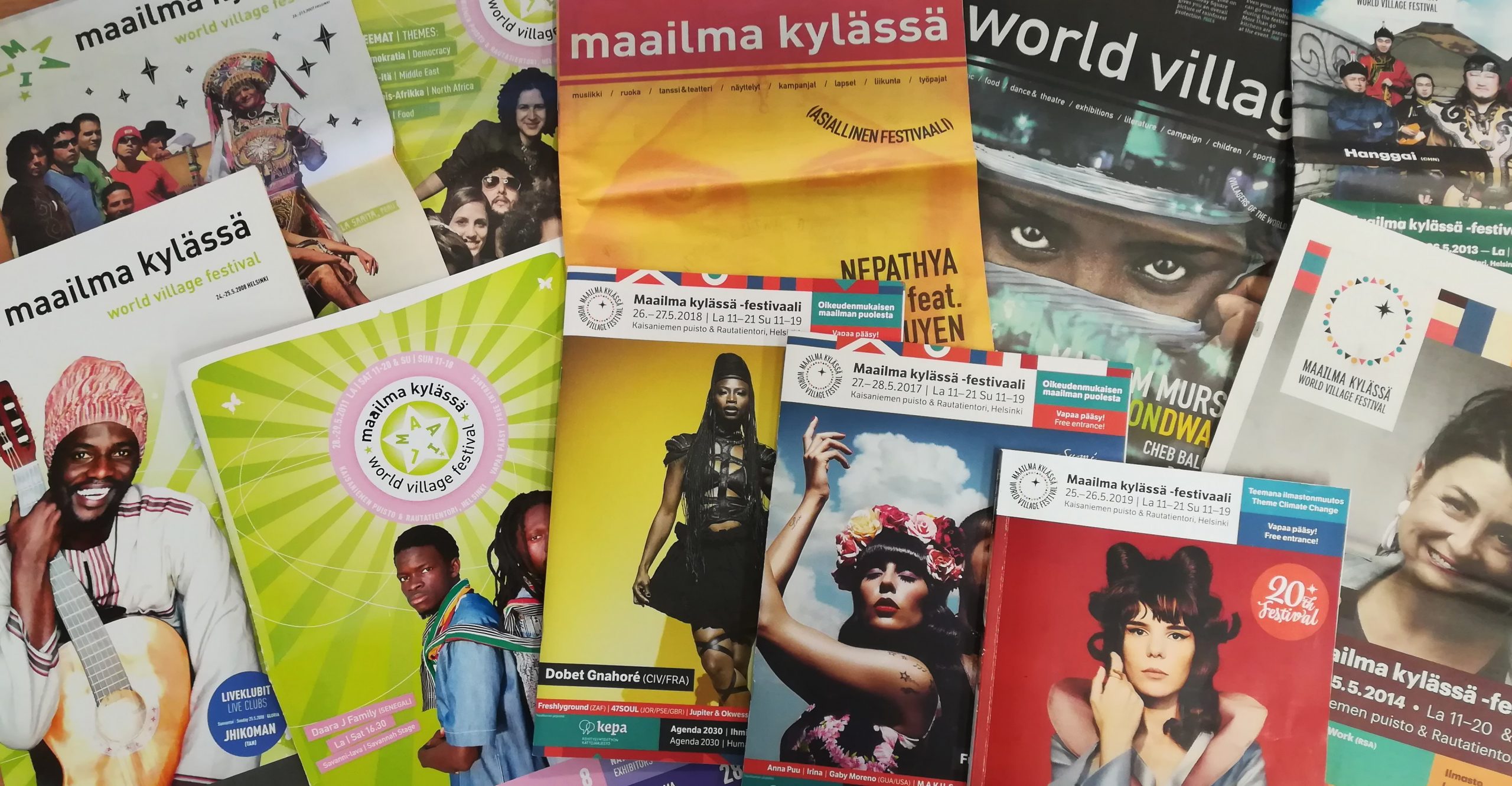World Village Festival was first organised in full in 1995. Over the years the festival has cemented its position as an annual meeting point between CSOs, festival visitors, politicians and thought leaders.
The roots of World Village Festival are in the 1980s, when the Vaasa Association for Developing Countries came up with a new idea for presenting civil society activities to the public. That idea begat the Market of Possibilities, which is still organised every year around Finland.
In Helsinki, the Market of Possibilities grew into World Village Festival, which was first organised in 1995. The festival and the Market of Possibilities were organised in alternating years until 2005, when the market became a part of the festival, which in turn became annual.
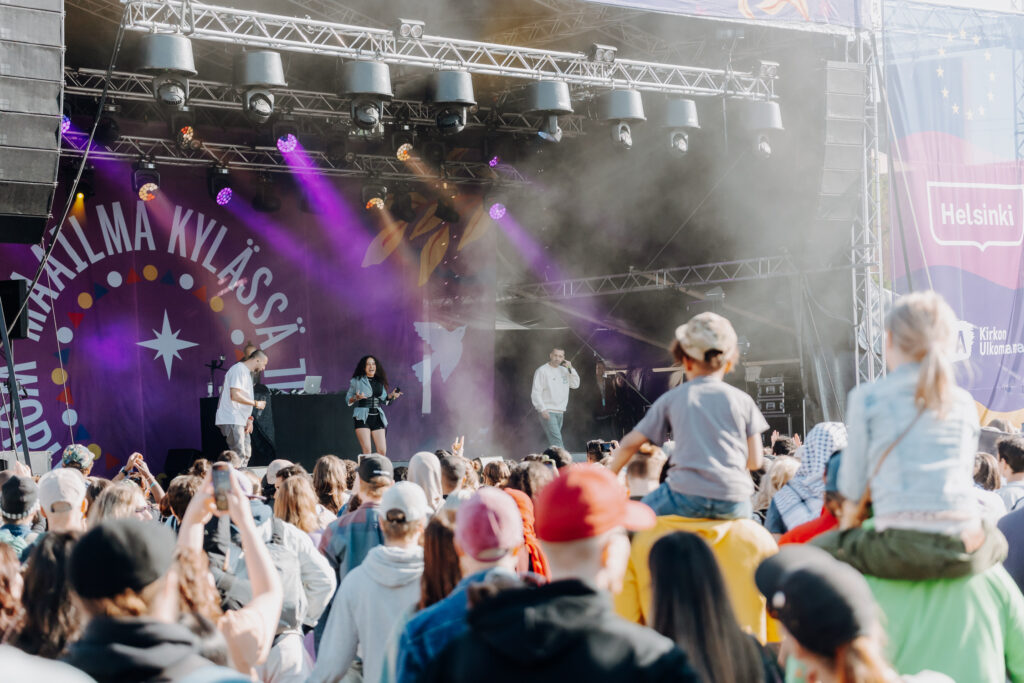
World Village 2025
Celebrating its 30th anniversary, the family-friendly event kicked off the Helsinki festival summer in a joyful and opinionated atmosphere. The festival attracted 27 500 visitors on Saturday and 32 500 on Sunday. In addition, the Speaker’s Stage programme was followed online by 2 000 viewers. The festival, with its message of peace, offered music from Finland and around the world, powerful speeches, tasty food and many other experiences, as well as hundreds of exhibitors. The theme of peace was heard throughout the festival.
On the Music Stage on Saturday, the Sound of Peace concert inspired people with its message of peace, and Grande Mahogany, Sarab and Majur charmed festivalgoers. On Sunday, Skidit-disko invited the kids to a dance party and Isaac Sene continued dancing with the crowd in the afternoon sun. Ana Tijoux, Ebo Krdum and DAM, among others, gave impressive speeches for peace between their shows. Funky Amigos Terrace Party provided upbeat dances during the breaks of the Music Stage.
On the Speaker’s Stage the audience was drawn particularly by the interview with Pekka Haavisto and the following programmes: Finland’s role in advancing a just and sustainable future in Palestine-Israel, When Your Peace Isn’t My Peace, Is there still a place for global rules, Daily life in the World –correspondents as bridge-builders and Seksikäs-Suklaa and Dosdela: music, humour and social peace. The audience was focused, impressed, and moved by the speakers’ experiences, messages, and themes.
Other areas of the festival also attracted visitors. The Market of Possibilities and all the 200 exhibitors were of great interest. The Book World was popular, and the Street Art area, the kids’ programme and YMCA Peace & Sports also inspired and encouraged people to take action for a better world and peace. Food was on the minds of many festivalgoers and the 40 food vendors at the festival filled many stomachs with tasty vegetarian food.
The festival ran smoothly in a positive atmosphere, with a large audience on both days from morning to evening. World Village set its own attendance record compared to previous Suvilahti festivals. People were in high spirits and Saturday’s cloudy weather didn’t affect the festivities. On Sunday, the event was celebrated in sunny weather.
Festival magazine 2025
Photos: World Village 2025
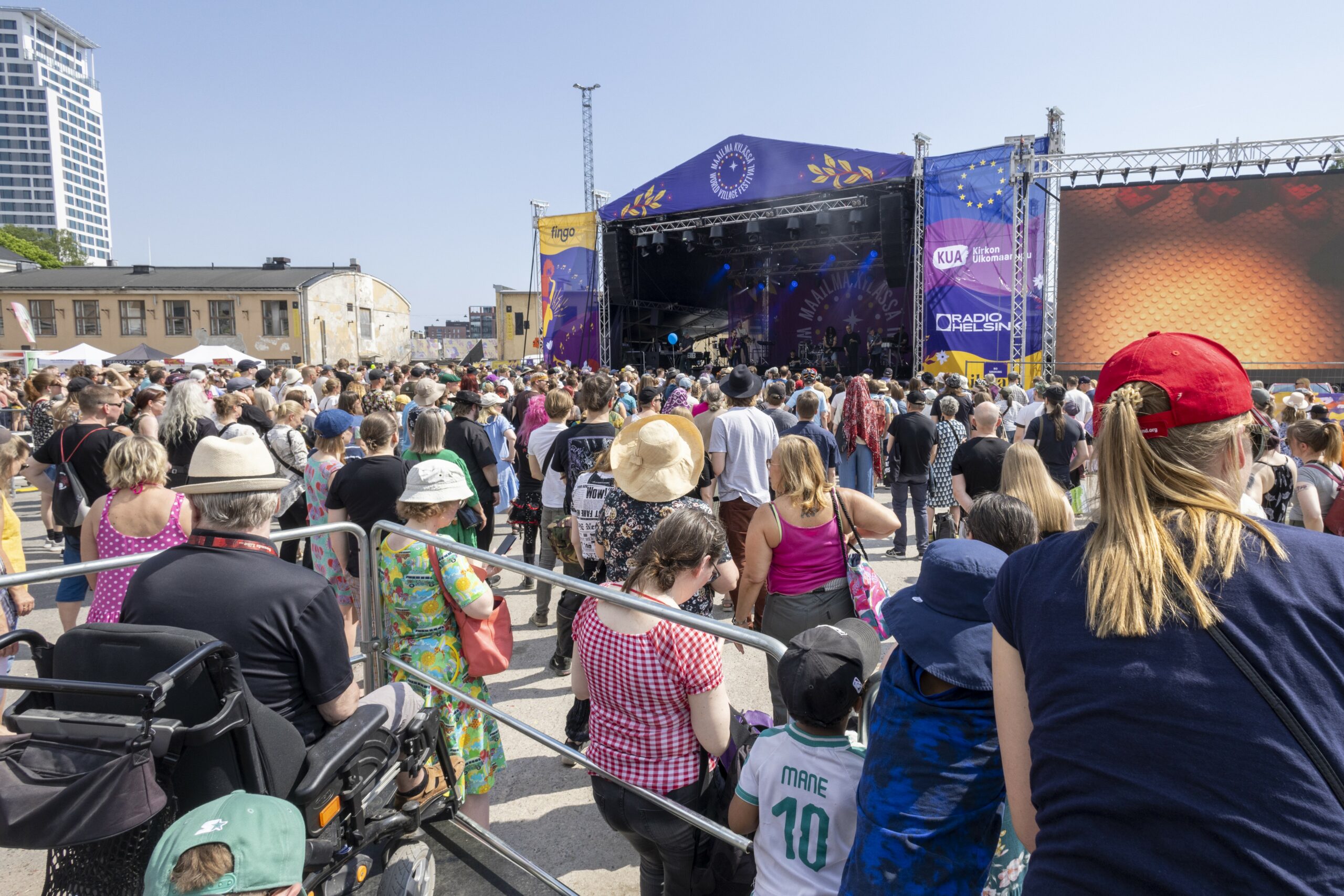
World Village 2024
World Village Festival was organized 25-26 May 2024 with the theme courage. Held for the second time in Suvilahti, Helsinki, the festival was attended by 45,000 people.
On Saturday, domestic acts Don Johnson Big Band and Hassan Maikal drew large audiences to the Music Stage. Colombian Puerto Candelaria and Australian Dub FX feat. Mr. Woodnote invited the audience to dance. The Music Stage also saw Children’s concert Indaba. Sunday’s music programme was opened by Finnish Antti Autio. The audience was also engaged by the amazing shows by Tunisian Emel and Finnish Maija Kauhanen. The festival ended in high spirits with the performance of multicultural Las Karamba. Funky Amigos Terrace Party rocked the decks between the live shows on the main stage.
The Speaker’s Stage was full during many talks and discussions for example during the interview of Ukrainian war journalist Illia Ponomarenko, who caught the attention of the media even before the festival. Popular programme items included the conversation featuring Laura Haimila and Emmi Nuorgam, the discussion between President Tarja Halonen and Aja Daffeh and the mini-EU election panel. International speakers Julian Kondur, Patricia Maruschak, Seme Nelson, Mazen Khzouz, Chrstine Kandie, Reena Lama and Julius Mbatia aroused interest in the festival audience as well.
All the festival elements were popular during the whole weekend, including YMCA Peace & Sport aimed for young people, the Market of Possibilities, Street Art Area, art exhibition, art installation and exhibitor tents. The Books and Recycling world had countless things to read and circular economy actors. Visitors in the Kids’ Corner enjoyed the Mobile Library and an abundance of workshops.
The 24th World Village Festival enjoyed sunny and warm weather. On Saturday the Festival had a threat of thunder and rain, but luckily the storm passed Suvilahti. The festival had 233 exhibitors, of which 137 were organizations. There were also educational institutions, companies, authorities and 131 volunteers. 46 food vendors offered flavours from around the world as usual, and this year the food was centered on vegetarian options. The main partners were Finn Church Aid, the European Commission Representation in Finland, the European Parliament Liaison Office in Finland, Radio Helsinki and Maailman Kuvalehti magazine.
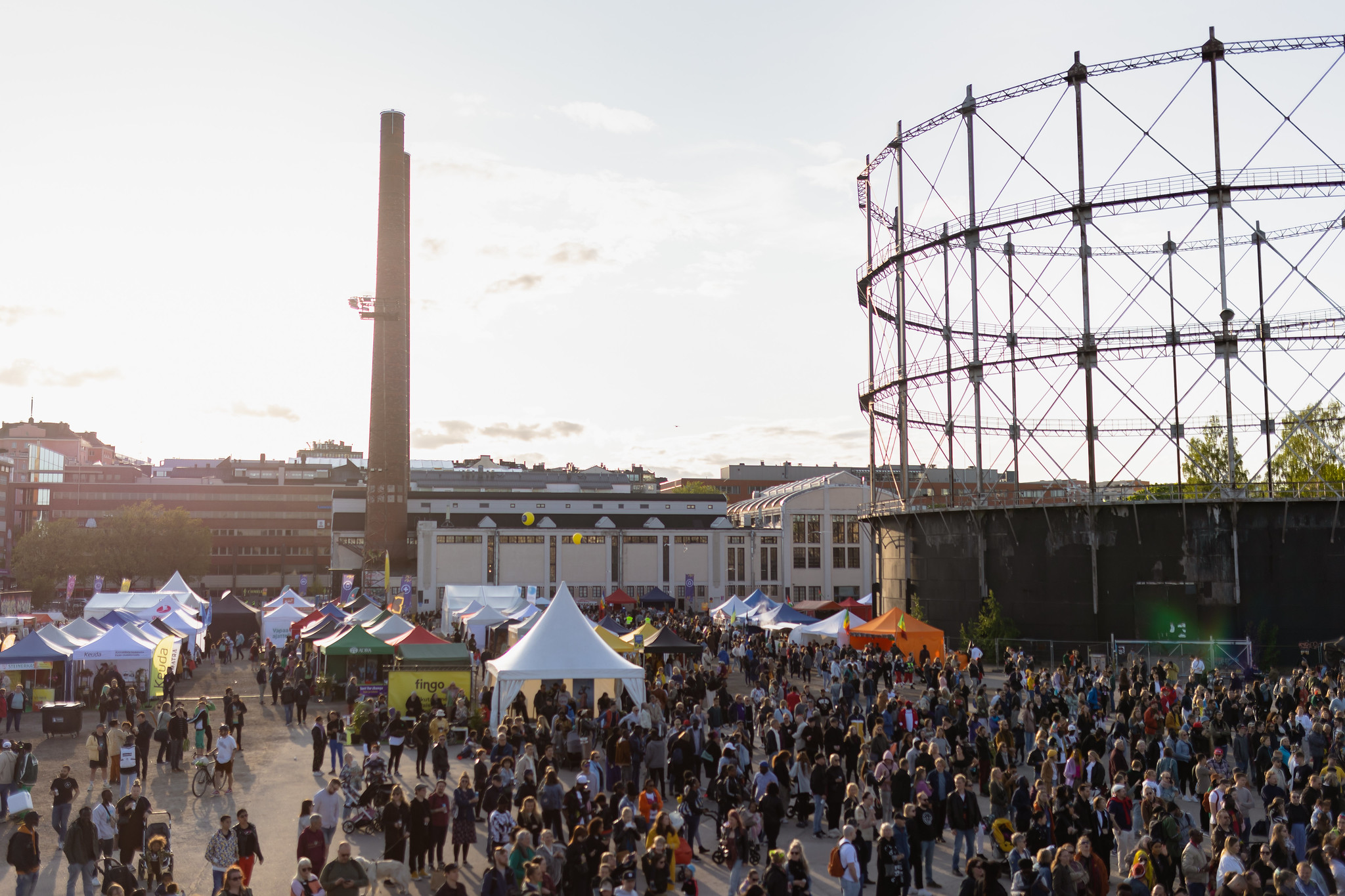
World Village 2023
World Village Festival attracted a crowd of 49,000 to Suvilahti, Helsinki 27–28 May 2023. Organised for the first time at the Suvilahti site, the civic influence festival was a great success and boasted a sunny and laid-back atmosphere. Theme – Force for Change! – was seen and heard throughout the programme and in encounters with the exhibitors, performers, and festivalgoers. The 23rd World Village Festival drew in crowds of people of all ages throughout the weekend. The gigs pulled in a lot of people, the programme at the Speaker’s Stage was popular, the Kids’ Corner was busy, and the exhibitors’ contents inspired people to learn about the activities of a couple of hundred CSOs.
The admission free festival had 75 program numbers, from concerts to talks, workshops, children’s programs, documentaries, evening clubs and an art exhibition. In addition to Fingo, the program was produced by 35 organizations. There were 214 exhibitors, of which 46 were food vendors and 132 were NGOs. There were also bazaar vendors, educational institutions, companies and authorities. About 80 volunteers were involved in the realization of the festival. About 1,000 viewers followed the talk show via the stream, and about 1,100 people participated in the side events.
On Saturday, the festival’s most-awaited name, Nigerian Afrobeat star Seun Kuti & Egypt 80, played to a packed Music Stage crowd and electrified the atmosphere. Toya Delazy, Yeboyah and children’s band Megasakki also pulled in keen audiences. Von Hertzen Brothers kicked off the Sunday with their fabulous concert. Great gigs were also played at the Music Stage by Liraz and Jesse Markin. Balaklava Blues touched the audience with their message about their home country, Ukraine, and their strong performance.
Thought-provoking speakers at the popular Speaker’s Stage included activists Winnie Masai, Helena Gualinga, Carmen Gheorghe and Tendai Makanza. Interdisciplinary stage poets Elsi Sloan, Iiris Laisi and Julian Owusu drew in a full house at Tiivistämö with their powerful spoken word performance.
The festival enjoyed beautiful, sunny weather. On Sunday, the wind picked up but there was no rain. The festival site was opened 15 minutes late on Sunday due to safety arrangements required by the high wind conditions. Otherwise, there were no disturbances or other incidents.
The festival’s main partners were Ministry for Foreign Affairs and Maailman Kuvalehti magazine.
Photos: World Village Festival 2023

World Village 2022
Exceptionally for this year, Word Village Festival for sustainable development was organised on several sites in Helsinki and in part online during the last week of May (23–29 May). With the venues comprising Allas Sea Pool, the Market Square, Tiivistämö event venue, Temppeliaukio Church and Kino Regina. The free festival featured more than 40 programme items from concerts to talks and discussions, documentaries and the exhibitors’ Market of Possibilities and attracted a total audience of 21,500 people. The theme of the festival was the Boundaries of Our Planet.
The film programme at the Online Cinema kicked off the festival on Monday 23 May, and the films were available until Sunday 29 May. The only documentary screened at a cinema was the animated documentary Flee, which was seen at Kino Regina on Wednesday 25 May at an event produced by the European Union. The Online Cinema had almost 1,200 viewers.
On Saturday and Sunday, the atmosphere at Tiivistämö’s talks and discussions programme was receptive and focused. The keynote speeches of Liselott Lindström, Ujuni Ahmed, Kumi Naidoo and Jason Hickel were particularly interesting, as were discussions by Minister of the Environment and Climate Change Emma Kari and Minister for Foreign Affairs Pekka Haavisto. The spoken word show of Laura Eklund Nhaga, Paleface and Hassan Maikal impressed the audience at near-full Tiivistämö.
There was also music at the Tiivistämö event venue. Orkesta Mendoza, the closing act on Saturday night, performed to a full venue. In the early evening, rap artist NaharY put on a brilliant open-air party at the Elephant Lounge terrace, where Funky Amigos dj’s were entertaining festival visitors throughout the festival weekend. Tiivistämö was visited by 1,800 people over the weekend. The streamed talks and discussions programme had about 1,200 viewers.
The main music event was organised on Sunday at the open-air stage of Allas Sea Pool. Tuure Kilpeläinen ja Kaihon Karavaani, Santrofi and Les Amazones d’Afrique filled the central Helsinki seafront site to the brim. Pikku Papun Orkesteri and SUAD also drew in big crowds. The concerts at Allas Sea Pool attracted a total audience of 10,000. The concert by Nicole Willis and Gospel Helsinki filled up the Temppeliaukio Church with an audience of almost 700 people.
On Sunday, the Market of Possibilities took place at the Market Square. The exhibitors’ area was organised on a smaller scale and there were no food and bazaar stands in the setup this year. The stands of civil society organisations and other sustainable development actors had a constant flow of visitors throughout the day, with the turnout totalling around 7,000 people.
The programme also included an art exhibition at Tiivistämö, a collaborative art workshop at Allas Sea Pool and an art performance at the Market Square. Four new episodes were also added to the World Village Festival podcast series this spring.
At the start of 2022, the plan was to organise the festival on a full scale. Because the pandemic situation still appeared very uncertain, and the financial risks of organising a large event were too high, the decision was made to scale down the event.
Nearly 30 different organisations and other stakeholders were involved in producing programme items for the festival. The Market of Possibilities showcased over 50 exhibitors. The festival’s main partners were the Lutheran Church in Helsinki, Ministry for Foreign Affairs, European Commission in Finland, European Parliament Information Office in Finland and Maailman Kuvalehti magazine.
Photos: World Village Festival 2022 and the Market of Possibilities
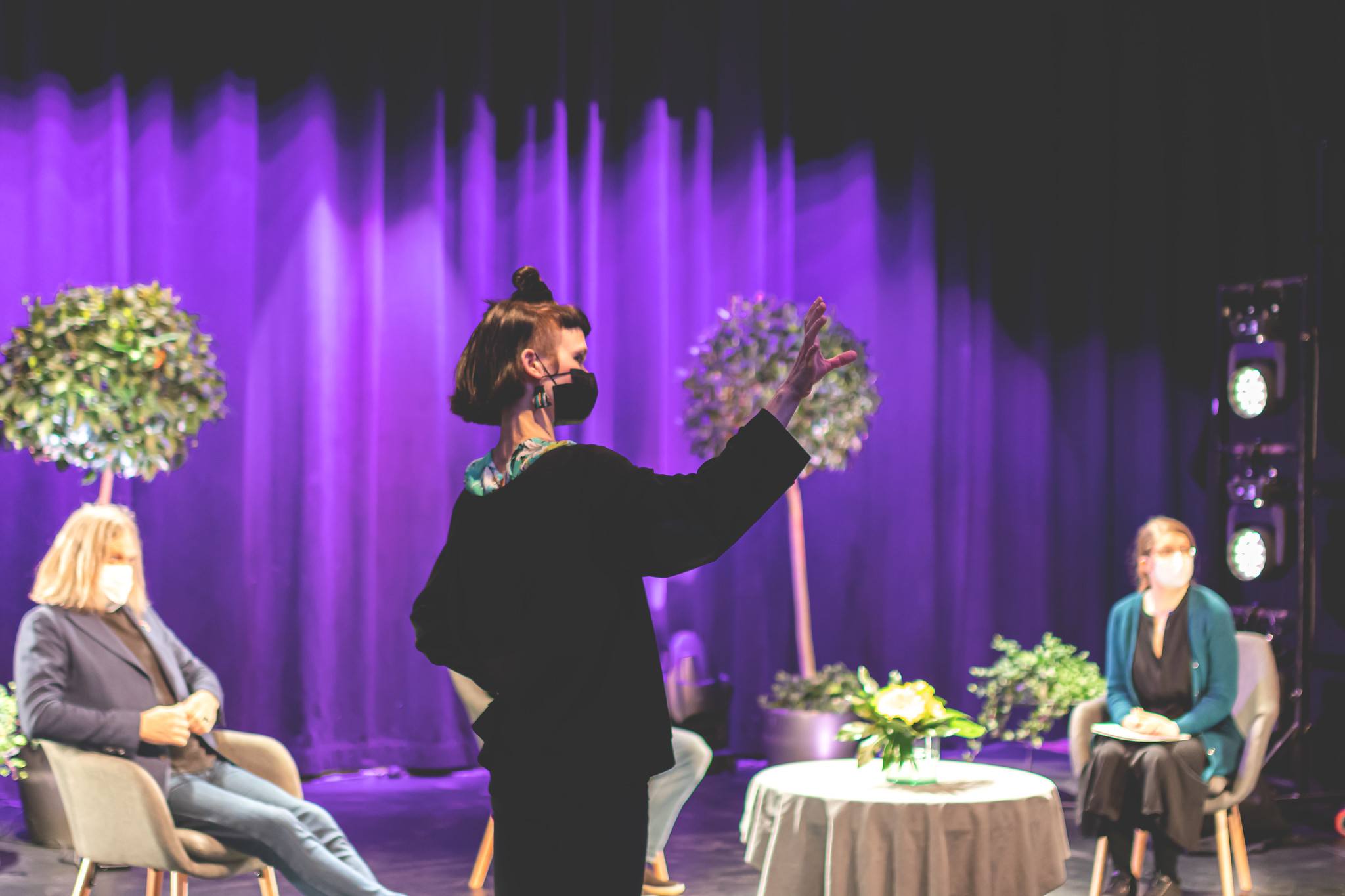
World Village 2021
World Village Festival was organized on 29–30 of May 2021. The festival was held virtually due to ongoing covid-restrictions. The festival programme was available for viewing also during the week after the festival, from 31 May through 4 June. There were over 60 individual programme numbers: speeches and discussions, concerts, documentary films and kids’ programme. Over 10 000 people viewed the programme. The theme of the festival was Future.
The headliner of the festival was Finnish pop icon SANNI, whose performance drew hundreds of people on the festival platform and lit up the chatroom. Representing the native people of the Pacific Island states, Small Island Big Song brought viewers from as far as South-East Asia. In total, the festival programme was viewed from 54 countries around the world.
In addition to SANNI, domestic performers included Frankosun & Family, who also recorded a live album at the festival with the rhythm music legend Jimi Tenor. Nicole Willis performed live from Agricola Church with the Gospel Helsinki choir.
International performances were carried out around the world. In addition to Small Island Big Song, the lineup included Algerian and Ecuadorian Sarazino, German-Syrian Shkoon, Venezuelan Betsayda Machado & Parranda El Clavo, Kurdi musician and master of Persian music Kayhan Kalhor, Malawian Madalitso Band, Indian Grammy winner Ricky Kej and Haitian Lakou Mizik.
The virtual festival offered activities for children too. The music stage hosted award-winning children’s music band Mutaveijarit (“Mud Buddies”) and the Skidit Disco World Tour (Kids Dico World Tour) that inspired everyone to get up and dance. The Junior Science Workshops hosted by Aalto University Junior taught participants how to make bioplastic and playdough.
Speech programmes were particularly popular at the virtual festival. The most viewed factual programme numbers included “Good and sustainable life – paradox or the way to the future?” by Siemenpuu Foundation, “Food for Thought: Three course menu” by UN Association of Finland and other UN organizations, and programme by Ministry for Foreign Affairs of Finland where young people from the Changemaker network quizzed Minister for Foreign Affairs, Pekka Haavisto, and Minister for Development Cooperation and Foreign Trade, Ville Skinnari. For the first time ever, the festival also introduced the popular Japanese speaking format, Powered by PechaKucha, where speakers have 20 images and 20 seconds per image to convince the audience of their topic. The Powered by PechaKucha programme number was hosted by reporter Ina Mikkola.
The keynote speakers of the festival brought up the future of the environment and human rights. Icelandic author Andri Snær Magnason touched upon how our current language is incapable of expressing the magnitude of a crisis like climate change. Kenyan human rights activist and former Special Rapporteur for the UN, Maina Kiai, underscored that human rights and democracy cannot be taken for granted. A familiar face to the Finnish audience, actor and Member of Parliament Pirkka-Pekka Petelius delivered his speech straight from Nuuksio national park and emphasized the importance of protecting the environment. President Tarja Halonen focused on exploring what a sustainable future will look like in a post-covid-world.
This year, World Village Festival is even more efficient in its quest to act as a messenger for a sustainable future, also outside the festival dates. In Spring of 2021 a new concept – the World Village podcast – was launched. During its first season, the podcast addressed topics like climate goals, nature’s diversity, international negotiations, sustainable funding, today’s activism and the importance of conversation skills. The podcast was spearheaded and hosted by reporter Susani Mahadura.
Nearly 30 different organizations and other stakeholders were involved in producing programme numbers for the festival. The virtual festival platform showcased 67 exhibitors. The festival’s main partners were Lutheran Church in Helsinki, Ministry of the Environment, Ministry for Foreign Affairs, European Commission in Finland, European Parliament Information Office in Finland and Maailman Kuvalehti magazine.
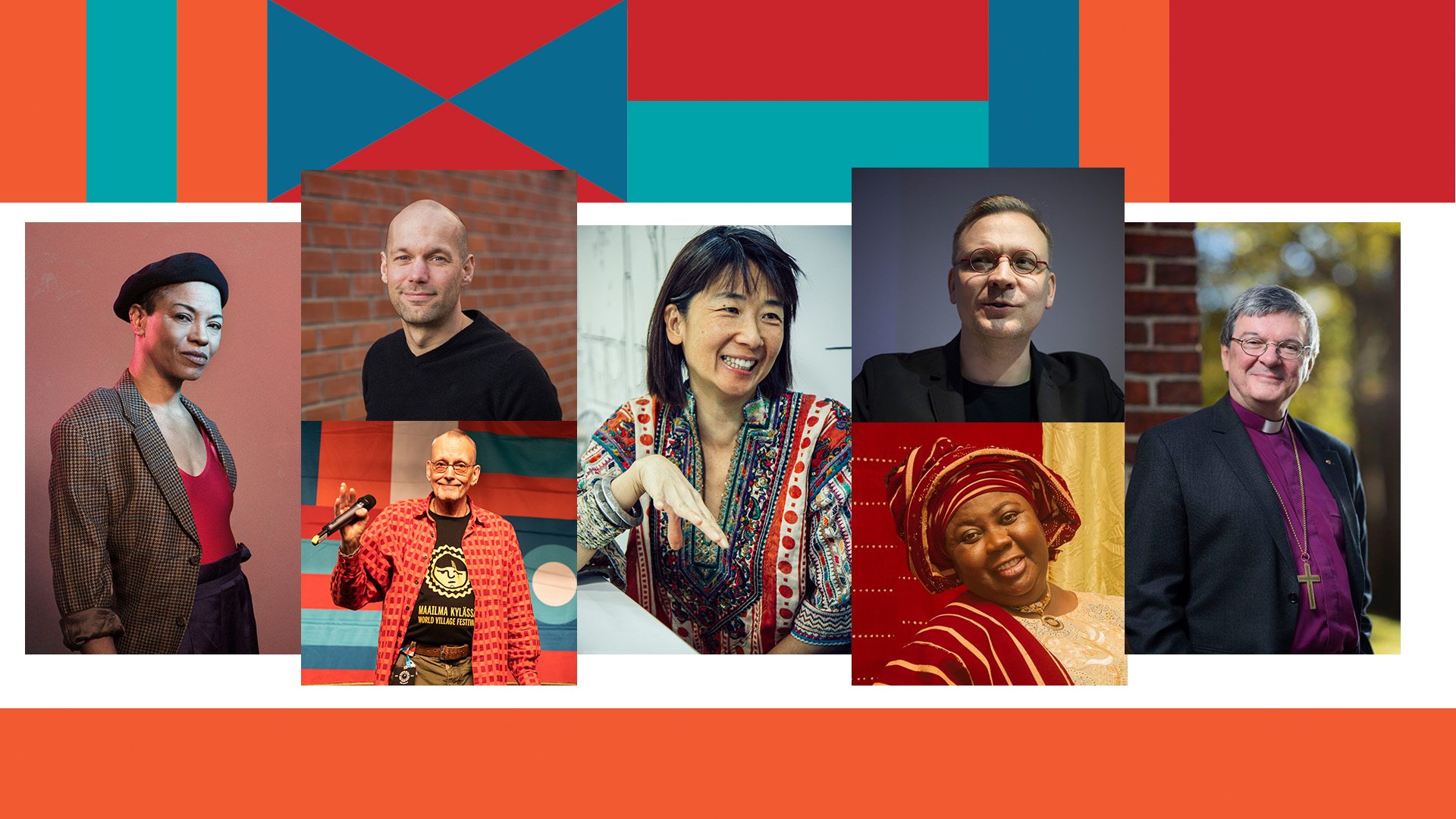
World Village 2020
In 2020 the festival was cancelled due to the Covid19 pandemic. Festival’s programme was already finalized and parts of it had been published. Hundreds of exhibitors had reserved their stands from the area and several volunteers had also signed up. The theme of the festival was supposed to be the future. Instead of the public outdoor event, a World Village Radio was arranged with Sosped Foundation.
The festival radio programme featured, for example, president Tarja Halonen’s visions of a more sustainable future and celebrations of the UN’s 75th anniversary. Artist Nicole Willis, documentary maker Iara Lee, futures designer Minna Koskelo and Bishop to the Archdiocese of Turku, Kaarlo Kalliala. Special musical programme was provided by DJ Hermanni and DJ Goodblood from the Boom Shakalaka Collective, and Papá Montero.
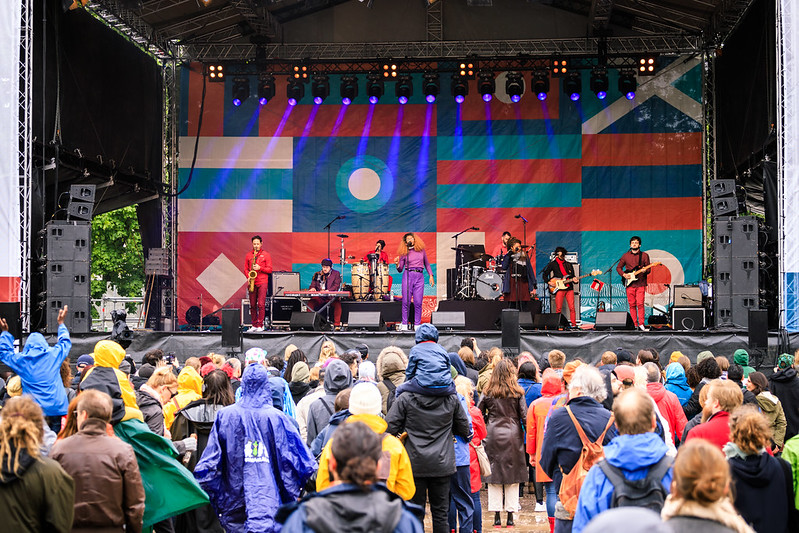
World Village 2019
World Village Festival was organized for the 20th time on 2019. The festival focused on climate change issues especially through the factual programme and the audience got to see artists from all around the world. The festival was organized in Kaisaniemi park and Railway square, 25–26 May 2019 .
The main stage was taken by Liniker e os Caramelows, one of Brazil’s most intriguing new musical phenomena, and “Istanbul’s new voice”, Gaye Su Akyol. To celebrate the 20th World Village Festival, Amparanoia, one of the most famous alternative bands in Spain, brought their versatile sound and revolutionary message back to Helsinki – their figurehead Amparo Sánchez had performed at the festival also in 2014. The festival started with The World Village Festival 20 concert, which brought back artists from the festival’s past but also introduced new ones – ones we hope to see in the future.
The factual programme focused on climate change questions. In addition to individuals’ choices and responsibilities, also larger political questions and initiatives were discussed. Young activists were at the spotlight, for example Nike Mahlaus from German Ende Gelände led the audience to ponder about what type of climate activism Europe need right now. European Parlament Elections were held on the same weekend as the festival and a panel with the candidates held by festival’s main organizer, Fingo, gathered a big audience.
The movie programme was also climate change centered. Benedikt Erlingsson’s Woman at War talked about activism’s role in combatting climate change and rewarded Yasuni Man gave the stage to Waorani people battling oil companies and Ecuadorian government in order to survive. Internationally known documentarist and activist Iara Lee brought her new documentary, Wantoks – Dance of Resilience in Melanesia, to have its world premiere in World Village Festival.
The childre’s programme consisted different concerts and workshops. In children’s area families could participate for example in Silent Disco and make art out of recycled things. During the whole festival, a car race was going on in the Market of Possibilities tent. Janne Käpylehto had built a racing track where the cars moved with the energy produced by jumping!
Festival’s pre party presented by Fiesta Latina took place in On the Rocks. Saturday’s afterparty happened with Uptown Helsinki and on Sunday the afterparty was celebrated at the same time with Finland’s ice hockey world championship at Apollo terrace with Afro Sunday DJ’s.
The biggest NGO event in Finland collected about 400 organizations, government institutions and other exhibitors to Kaisaniemi park and Railway square in 2019. In addition, almost 60 street kitchens were serving food from over 30 different countries’ food cultures. Despite the rainy weather, the event was visited by approximately 45 000 people.

World Village 2018
The main theme of the 2018 World Village Festival was the 2030 Agenda for Sustainable Development. The festival’s regional focus was on Africa. The festival was held in Kaisaniemi Park and Railway Square on 26–27 May.
Festival artists on the main stage included South African mainstay Freshlyground, Grammy-winning singer Dobet Gnahoré, Congolese band Jupiter & Okwess, Finnish reggae star Raappana and 47SOUL, the Palestinian innovators of the modern genre of shamstep, a fusion of folk and electro.
The festival hosted discussions on topics such as everyday consumer choices, climate change, corporate responsibility and human rights, with a number of voices giving their views on solutions and political measures for a just and sustainable world. Speakers included President Tarja Halonen, actor Aku Hirviniemi, human trafficking victim Itohan Okundaye and Minister of the Environment Kimmo Tiilikainen (Centre Party), who discussed Finnish emissions goals in a Kepa Talks panel.
For the festival weekend, On the Rocks on Mikonkatu was transformed into Village Cinema, the festival’s venue for documentary films. The documentary programme featured films on the challenges of family reunification, the effects of globalisation, the peace work of individuals and more. The festival audience was also treated to the world premiere of Kotimaa Kosovo-Suomi, Olli Laine’s documentary telling of the story of the Hetemaj family, known for their achievements in politics and sports. The screening was accompanied by an interview with the Hetemaj family and director Laine.
Children’s programme consisted of concerts and workshops. The Children’s Corner featured much to do as usual, including lectures on African rhythms and crafts sessions with recycled materials.
The evening continued at the festival clubs. On Saturday, Finland’s top Latin club Fiesta Latina took over On the Rocks, while Afro Sunday DJ’s took over the terrace of Apollo to keep the crowd dancing on Sunday.
Finland’s largest CSO event assembled a total of 406 exhibitors, including 253 CSOs and roughly 60 food vendors, at Railway Square and Kaisaniemi Park. Approximately 80 000 guests visited the festival area during the weekend.
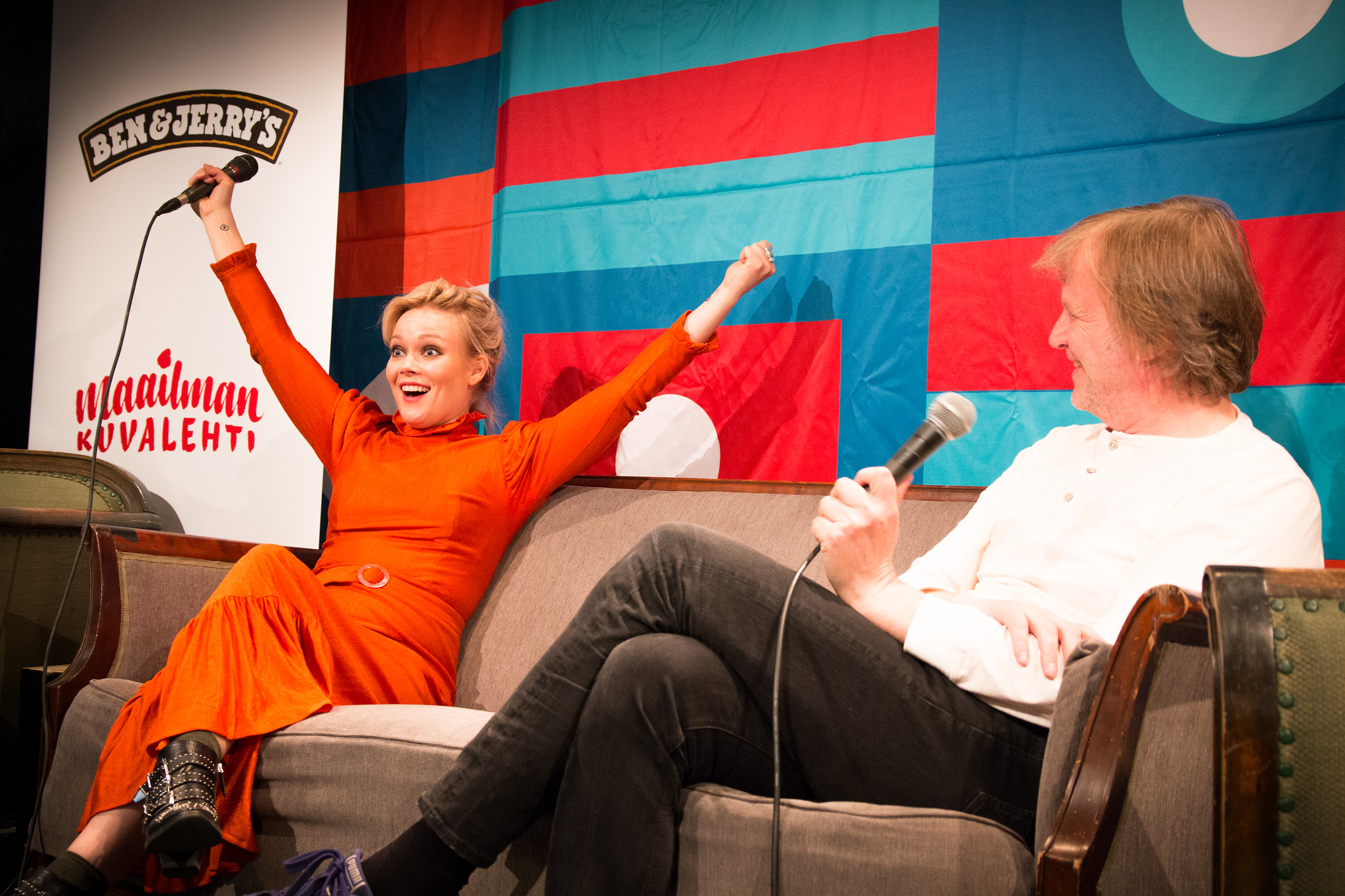
World Village 2017
The main theme of the 2017 festival was civil society and the regional focus on Latin America. As usual, the festival was held in Kaisaniemi Park and Railway Square on 27–28 May.
The weekend’s biggest attractions included Finnish acts like Anna Puu and Irina, the fiery flamenco rhythms of Fuel Fandango from Spain and M.A.K.U. Soundsystem from Colombia. Sunday’s lineup took a hit at the last moment as singer-songwriter Gaby Moreno was stranded in London due to technical difficulties at the airport. Brazilian outfit Aláfia were thus moved up to close out the festival, and they did not disappoint.
The festival’s talk programme covered topics such as refugees, inequality and the state of civil society. Decision-makers’ panels had politicians from all over the political spectrum looking for solutions for achieving sustainable development goals and realising corporate responsibility. The festival introduced visitors to different ways of working for a just world, offering concrete ways to participate, for example by volunteering with CSOs.
Movies and documentaries with social themes were screened at a new venue, Kino Caisa, which was hosted within Cultural Centre Caisa. Discussions that followed screenings tackled issues like the status of trans people and the state of civil society in Latin America. Following the showing of his film The Wait, filmmaker Maher Abdulaziz took part in a discussion on the role of the Syrian diaspora in rebuilding their wartorn home country.
Nearly 400 exhibitors, including 270 CSOs, participated in the festival in Kaisaniemi Park and Railway Square. The festival menu was once again varied, thanks to the 60 food vendors present. Over the weekend, roughly 78 000 visitors attended the festival.
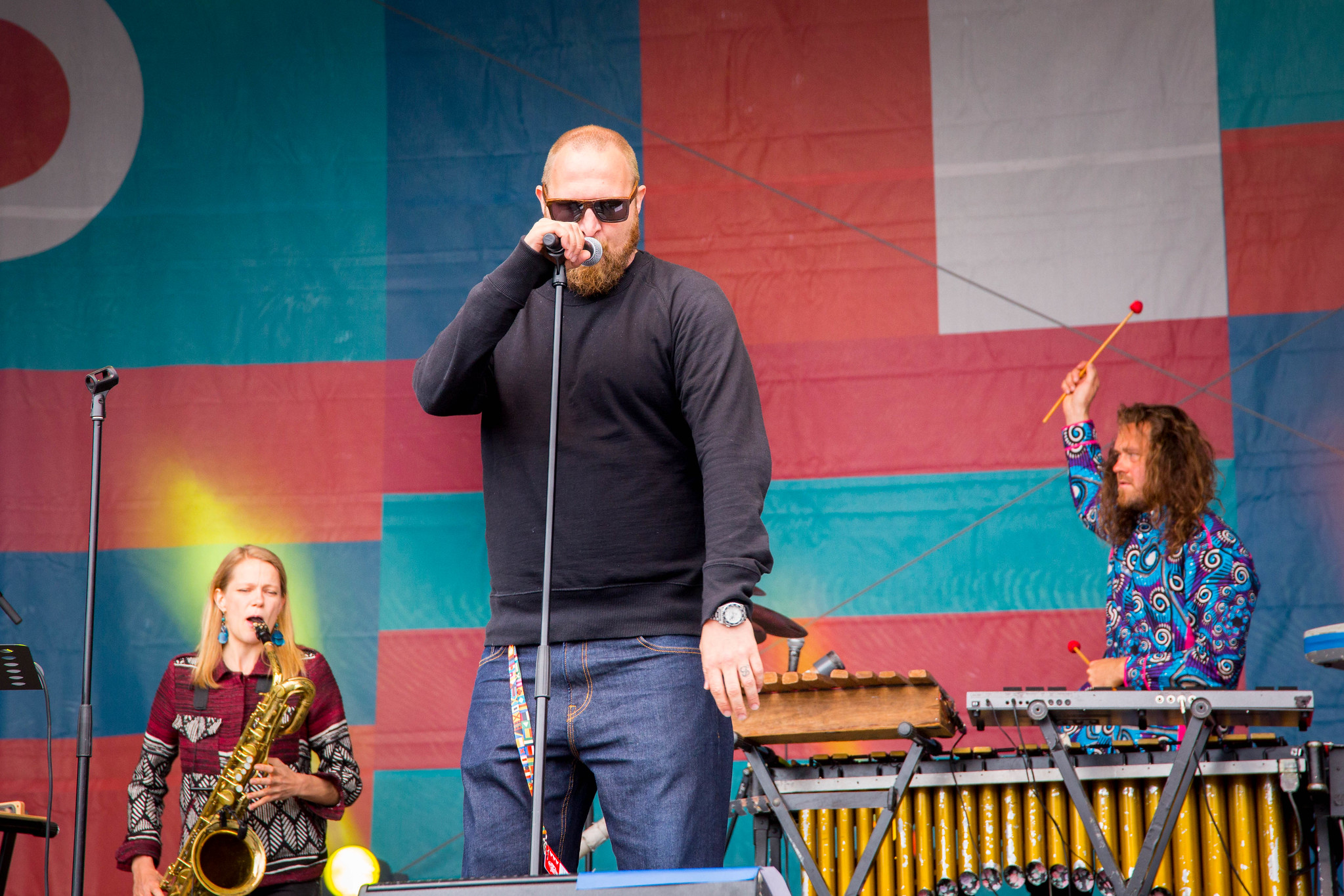
World Village 2016
In 2016, World Village Festival’s focus was on justice and Asia. Other themes included civil society, refugees, climate and environment, sustainable economy and the 2030 Agenda. 79 000 visitors attended the festival in Kaisaniemi park and Railway square over the weekend 28–29 May.
Festival headliners included Nigerien Tuareg artist Bombino, a British group with Indian and Pakistani heritage in Asian Dub Foundation, Swedish political rappers Looptroop Rockers, Punjabi–American–Danish mixture Alo Wala and South Korean electro trio Idiotape. Finnish highlights included Scandinavian Music Group, Teho Majamäki & Travelogue Ensemble and Mira Luoti.
As usual, there was much for children to do. The festival opener was a children’s concert by Satuja Soitosta on Savannah Stage, while the Reuse Centre taught Kids’ Corner visitors – among other topics – doll house renovation.
Justice was a strong theme in the film and talk programmes. Emmy-winning documentary filmmaker Deeyah Khan screened her film Jihad – A Story of the Others, which was a part of a wider discussion on radicalisation and the refugee experience at the festival. A film on human rights in China also attracted much interest. The talk programme included President Tarja Halonen discussing emergency relief with Red Cross and Red Crescent Societies Under Secretary Jemilah Mahmood. Leaders of Finnish parliamentary parties were questioned by Kepa’s experts about reconciling energy issues with economic ones.
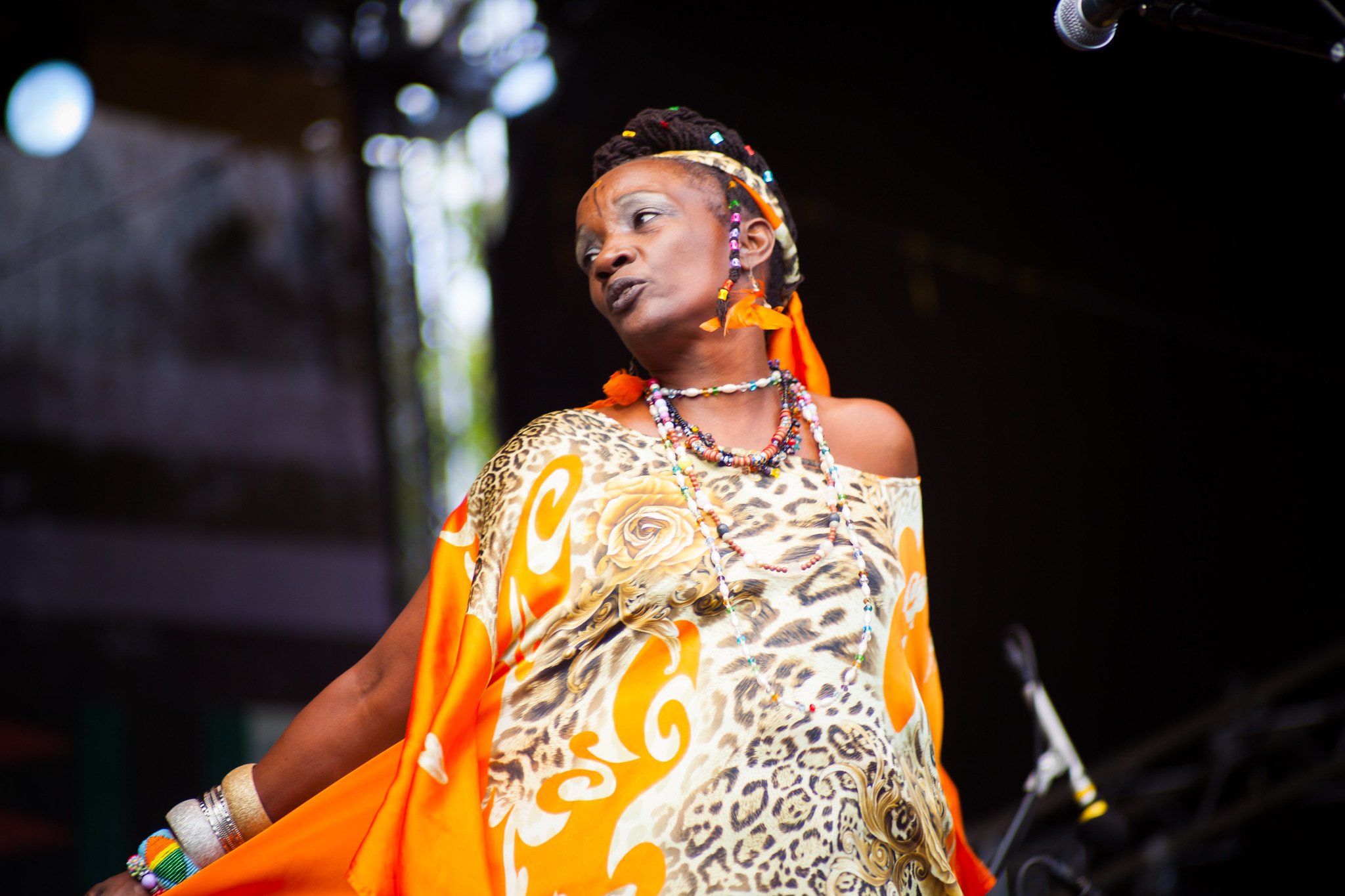
World Village 2015
The 2015 festival offered visitors a varied programme and rhythms from Africa and the Middle East. On its 20th anniversary, the festival’s main theme was development and the festival audience numbered approximately 77 000. The festival was held in Kaisaniemi Park and Railway Square 23–24 May.
Saturday’s headliners included kora virtuoso Ba Cissoko, Sahrawi singer Aziza Brahim and Sierra Leone’s Refugee All Stars, who performed courtesy of the Finnish Red Cross and delivered a reminder about the Ebola epidemic in West Africa. Sunday at the festival saw the premiere of the most interesting jazz project of the summer as UMO–Helsinki–Cotonou took to stage. Sunday’s main stage lineup also included a performance by Lebanese Mashrou’ Leila and a joint concert by Afrobeat legend Orlando Julius and modern jazz collective The Heliocentrics. The weekend’s top Finnish names included pop singer Janna, the laid-back Kaveri Special, Finnish reggae star Aurora and the always original Pietarin Spektaakkeli.
Kids’ Corner hosted plenty of events throughout the weekend. Saturday at the festival kicked off with a performance of children’s musical story Nukkearkku – matka-arkun salaisuus, while Sunday began with a show by Satu Sopanen ja Tuttiorkesteri.
The factual programme discussed – in addition to the main theme – the environment, inequality, peace work and the global economy. Freedom of speech was the topic of a talk given by Guantánamo Diary author Larry Siems and a panel discussion between Finnish journalists. The festival also hosted Docventures Lounge for the first time, bringing films and documentaries to the Stage Club of the Finnish National Theatre.
The free festival included a total of 60 street kitchens and hundreds of exhibitioners. Scattered showers did not hamper an otherwise sunny festival, which ran smoothly through the weekend.
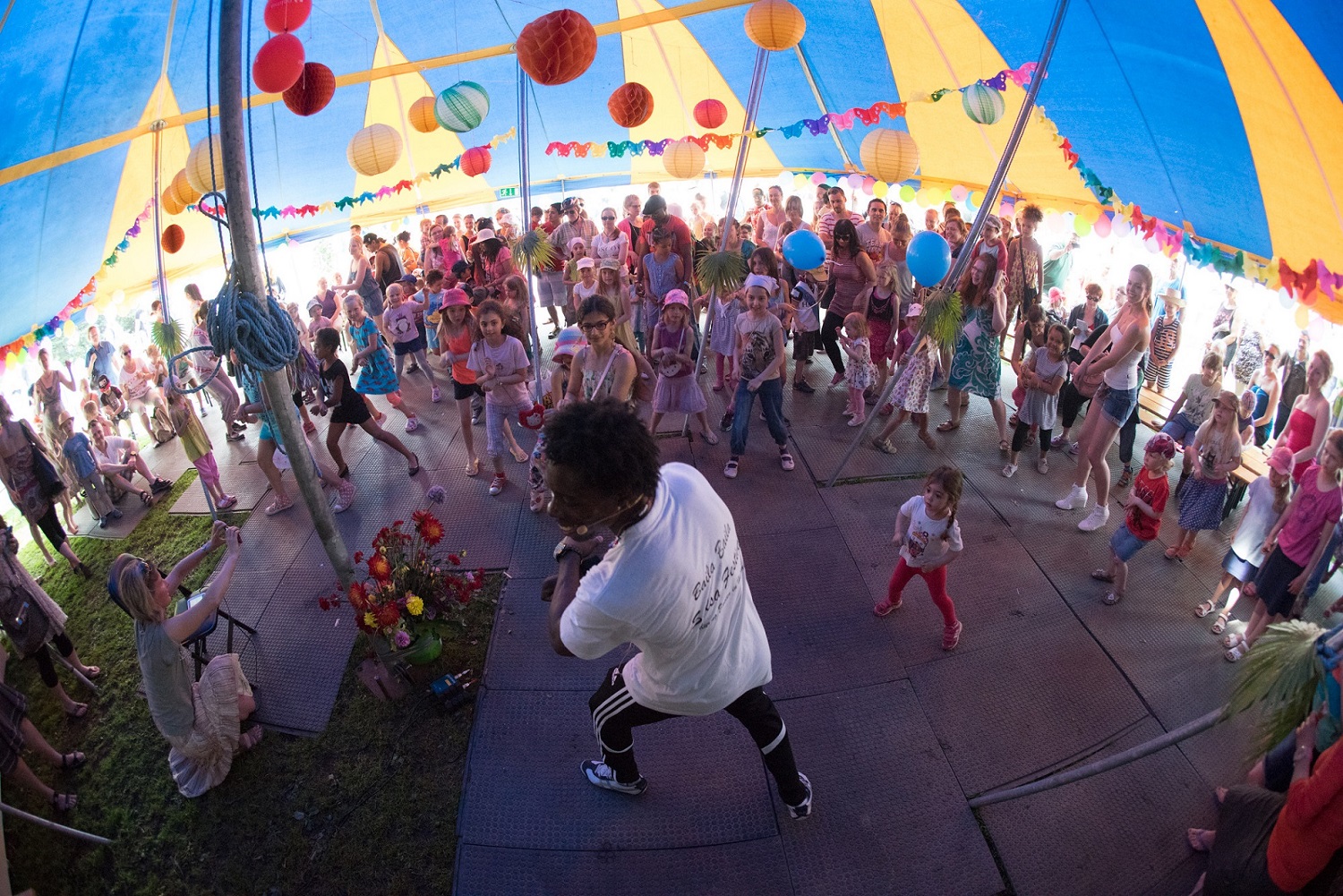
World Village 2014
The 15th World Village Festival offered its audience a cornucopia of music and a factual programme centred on climate issues in Kaisaniemi Park and Railway Square. 80 000 visitors made their way to the festival over the weekend 24–25 May. The sunny weather kept everyone in a positive mood and the festival went off without a hitch.
The festival’s Saturday highlights included Mexican band Los de Abajo and the soulful Spanish singer Amparo Sánchez. On Sunday, visitors were treated to a living jazz legend in Hugh Masekela, who implored everyone within earshot to fight global inequality. The festival’s international closing act was Mexican accordion virtuoso Celso Piña.
Finnish acts included Hiphop Allstars, a group of top acts who joined forces specifically for World Village Festival, and the live premiere of Kuperseikkailu, which featured the talents of Mira Luoti, Anna Puu and more. Other domestic artists included the nostalgic Four Cats, Lauri Tähkä, Tuure Kilpeläinen ja Kaihon Karavaani, Minä ja Ville Ahonen and Wimme Saari ja Tapani Rinne.
A panel of experts discussed the coming climate negotiations and called for more ambition from Finland and countries around the world. CSOs offered solutions to the crisis in a special climate-themed tent, while international visitors represented the perspectives of groups such as small farmers and indigenous peoples. The Open Finland tent presented different aspects of Finnish society to recent immigrants. The factual programme also included discussions of the rights of Dalit women, the ethics of clothing, the future of eating meat, community media in Tanzania and the rights of disabled people in developing countries.
The all-ages festival once again attracted a large number of families. In 2014, a record 400 exhibitioners and 60 street kitchens participated, and the programme spanned six stages.
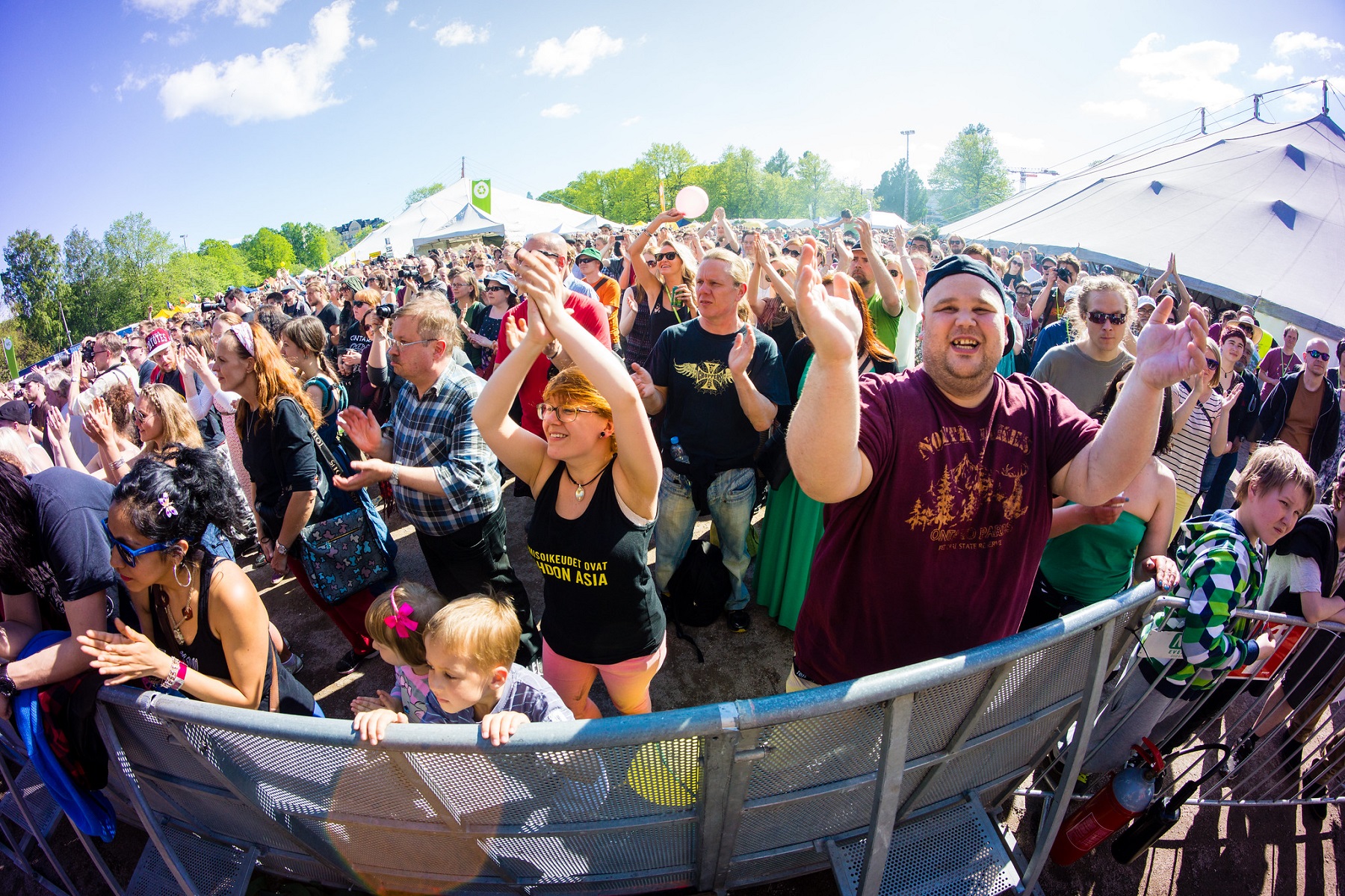
World Village 2013
Having solidified its place as the start of summer and a meeting point for those interested in global issues, World Village Festival gathered 85 000 visitors to Kaisaniemi Park and Railway Square on 25–26 May 2013.
The festival’s main theme was human rights, with theatre as a minor theme. Regional focuses were in Southeast and East Asia. The festival programme consisted of a record 285 events. 450 exhibitioners participated in the festival, including 60 food vendors and 300 CSOs.
The festival’s sonic landscape included the Korean post-rock of Jambinai, Charmain Clamor’s Filipino jazz, the psychedelic pop of The Cambodian Space Project, Hanggai’s Chinese hillbilly rock and the Indonesian indie of White Shoes & The Couples Company. Artists from beyond Asia included Sierra Maestra from Cuba alongside Kuukumina from Finland, Tanzanian Totoo Zebingwa & Sanaa Sana, Norwegian PelBo and Portuguese Melech Mechaya.
Domestic headliners were Ismo Alanko, who had recently released a new album, and PMMP, who ended their career in autumn 2013. Other Finnish acts included Don Johnson Big Band, Diandra, Kuningasidea, Johanna Juhola & Reaktori, Aino Venna, Color Dolor and children’s band Fröbelin Palikat.
The theatre programme spanned three stages, thanks to collaboration with the Teatris festival.
The factual programme dove deep into human rights, with discussions on racism, the kamalari slave system, politics, water, toilets, human trafficking, family planning, workers’ rights, development cooperation, global inequality, freedom of speech, prisoners of conscience and the economy.
The factual programme was amended on Friday before the festival weekend began, when two members of the Russian group Pussy Riot were able to enter Finland. A storm of media attention arose around Pussy Riot, with coverage in television and print. The media followed the festival closely over the entire weekend. The pseudonymous members of Pussy Riot cancelled their appearance on Saturday morning.
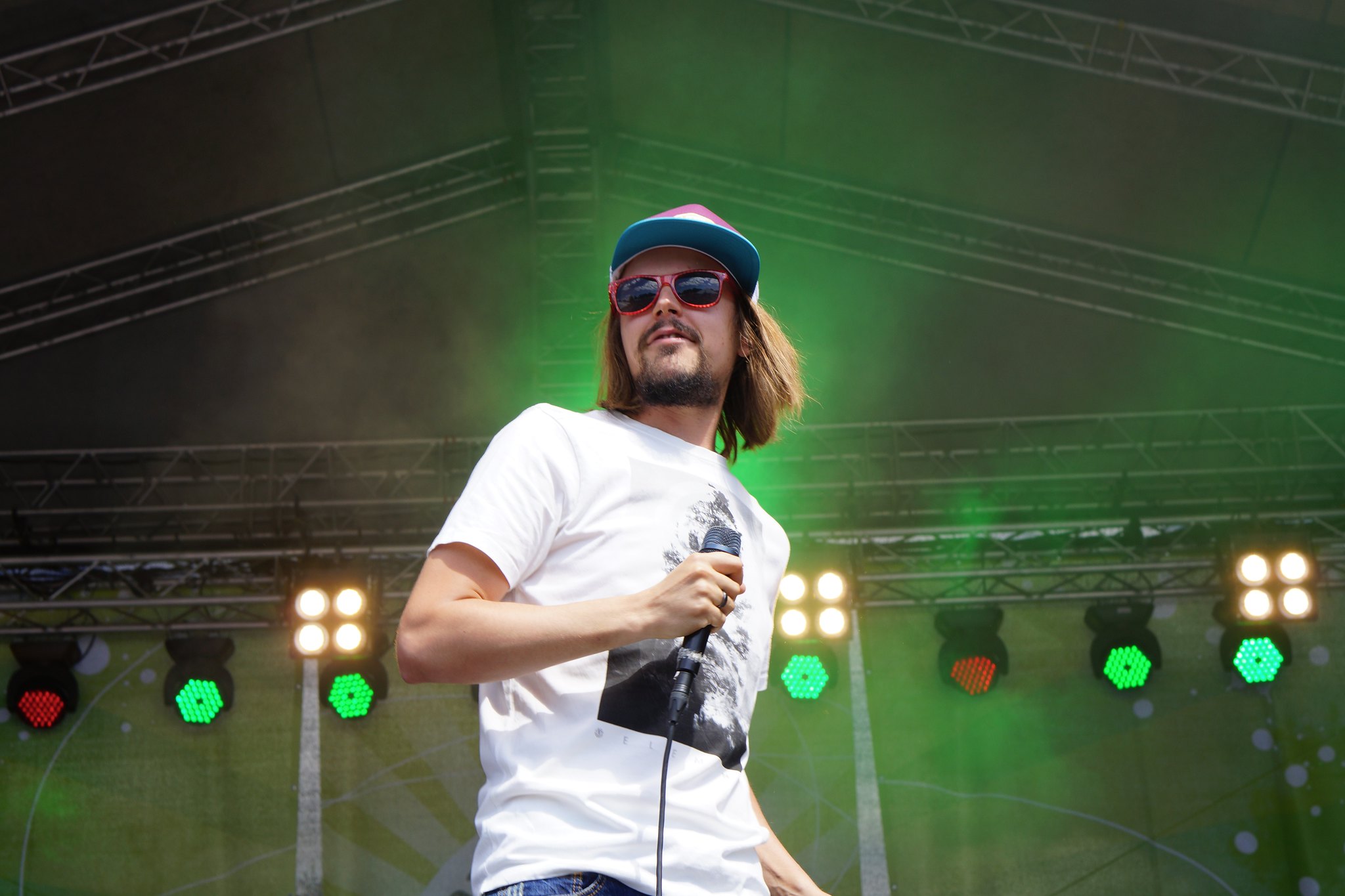
World Village 2012
World Village Festival 2012 was a record-setting event, attracting 105 000 visitors to Kaisaniemi Park and Railway Square over the weekend of 26–27 May. The festival’s main theme was democracy, while food was chosen as a minor theme. Regional focuses were in North Africa and the Middle East. The sun shined throughout the weekend.
The most popular performances of the weekend included Saturday shows by Arab Pop sensation Natacha Atlas and Finnish pop legend Paula Koivuniemi. Sunday’s biggest draw was the poster child of the Finnish reggae boom Jukka Poika with his Sound Explosion Band. International acts included Nicaraguan Perrozompopo and Israeli-Yemeni-American combination Yemen Blues. The audience was also enchanted by the sounds of a joint performance by Mariem Hassan – the queen of North African desert blues – the Algerian-French El Gafla and Finnish rapper Asa.
The festival’s varied factual programme included talks by a number of top politicians and authors, including President Tarja Halonen; government ministers Heidi Hautala, Paavo Arhinmäki, Ville Niinistö and Erkki Tuomioja; and authors Rafeef Ziadah, Boualem Sansal and Katja Kettu.
Visitors had an opportunity to experience the main festival theme first-hand in the voting installation House of Democracy. Actors posed as voting officials and gave visitors a taste of what an undemocratic voting situation feels like, surprising many and generating a lot of discussion.
New additions at the 2012 festival included local food oasis Herkkukylä and the FNT Stage Club with its film programme. Exhibitioners at the festival included 60 food vendors and 300 CSOs. The festival crowd was large enough to keep all venues packed.
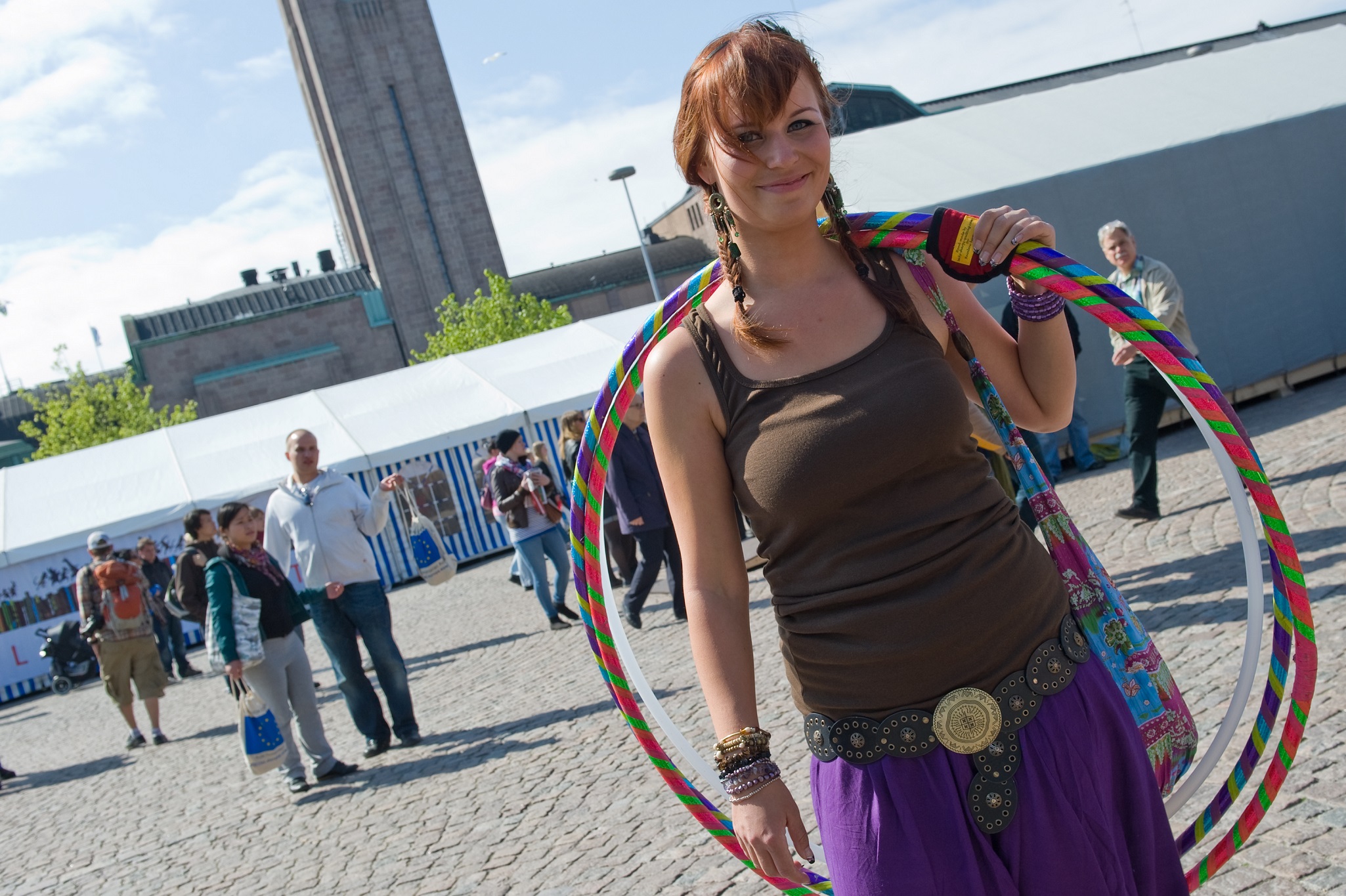
World Village 2011
Finland’s largest multicultural festival attracted an audience of 70 000–80 000 to Kaisaniemi Park and Railway Square over the weekend 28–29 May.
One of the brightest stars to perform at the festival was South African freedom singer Vusi Mahlasela. Attendees also got to enjoy the sounds of Senegalese Afro-hop pioneer Daara J Family, New Yorker Hazmat Modine, a joint gig by Afrobeat drummer Tony Allen and electro maven Jimi Tenor as well as a host of other performers from around the world.
Finnish acts included Yona & Pienet Liikkuvat Pilvet, Lepistö & Lehti, Uusi Fantasia, Signmark and punk band Pertti Kurikan Nimipäivät, who were reinforced on stage by Pelle Miljoona. Saturday’s party continued at the festival club at Virgin Oil Co.
Over 400 exhibitors from CSOs to food vendors and companies participated in the festival by presenting their activities and offering visitors exotic flavours.
The EU’s volunteerism theme year was also seen at the festival. A special effort was made by Munamies, who had children bouncing around with a message of positivity and volunteerism. Roughly 200 volunteers participated in putting the festival together, with another 1 000 volunteers working with participating CSOs. The popular uprisings in Egypt and Libya, accessibility and migration were also highly visible issues at the festival. The festival’s guests included author Ghada Abdel Aal, an active participant in the Egyptian uprising.
The festival atmosphere was broadcast over the airwaves during the entire festival week thanks to World Village FM, a radio project put on by students.
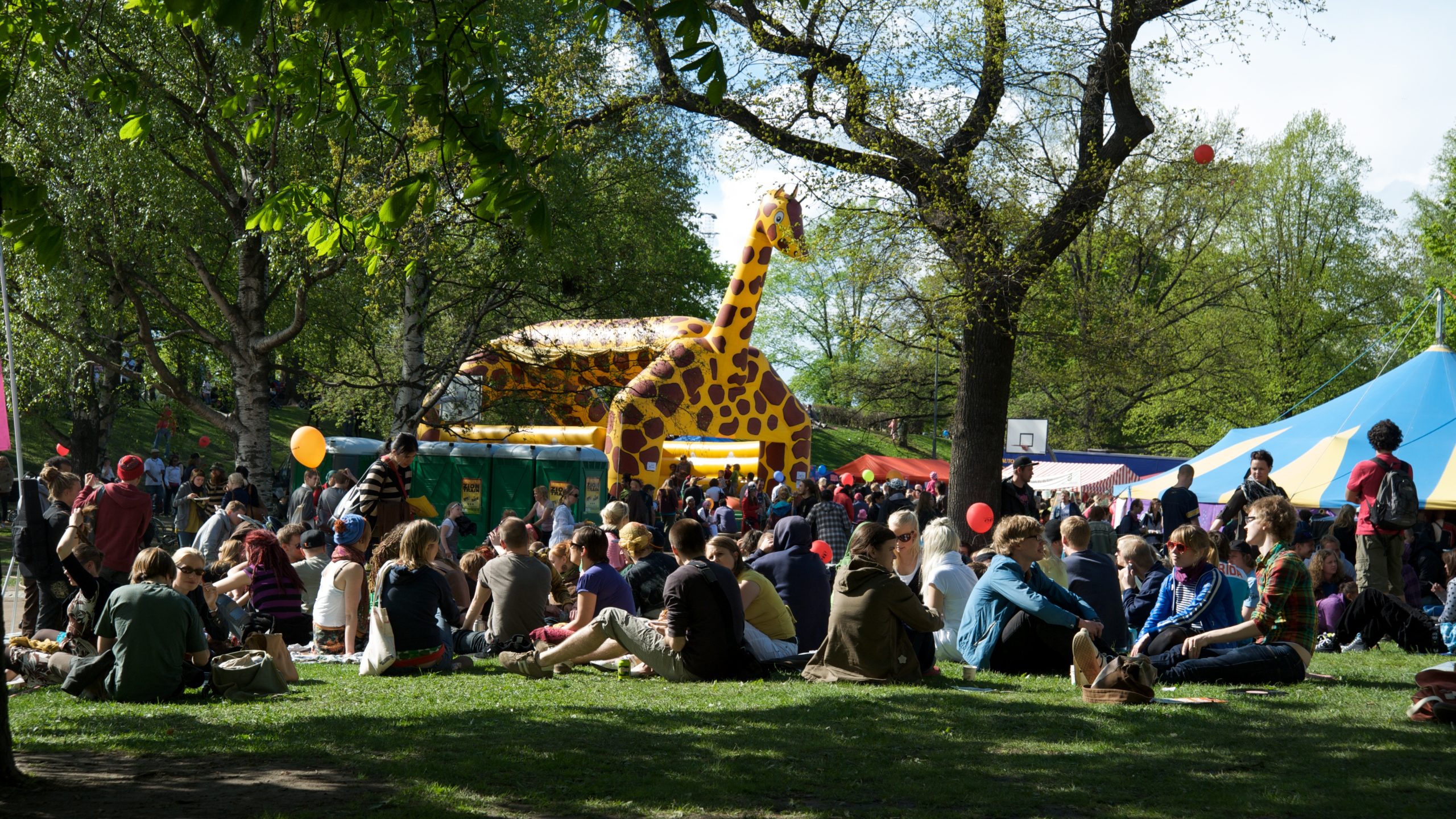
World Village 2010
In 2010, a varied music and factual programme as well as Sunday’s beautiful weather combined to draw a crowd of approximately 70 000 visitors to the festival. The festival war organized in Kaisaniemi and Railway Square 29–30 May.
On Saturday afternoon, Anna Puu charmed the audience with a radiant performance. One of the weekend’s most anticipated artists was Mad Juana, who closed out Saturday with a blast of reggae and rock rhythms. A sunny Sunday closed with the positive vibes of Afro-Colombian ChocQuibTown, whose show had the entire Kaisaniemi crowd dancing.
World Village Festival 2010 was held under the theme “200 paths to a better world”, a reference to the valuable work done by various CSOs. Kepa’s panel discussions pondered matters such as Finland’s role in combating global poverty. In the wake of the 2008 financial crisis, a proposed financial transaction tax gained popularity as a source of funding for climate change efforts and development cooperation, and the idea was endorsed in a panel discussion by members of the three largest parties in government.
The development-minded Globbyist network gathered citizens’ tidings to MPs at the festival with a postcard campaign. Messages on postcards encouraged those in power to take decisive action to fight climate change, global poverty and financial crises. These postcards were collected at popular events around Finland and delivered to MPs in a large Globbyist event in Spring 2011.
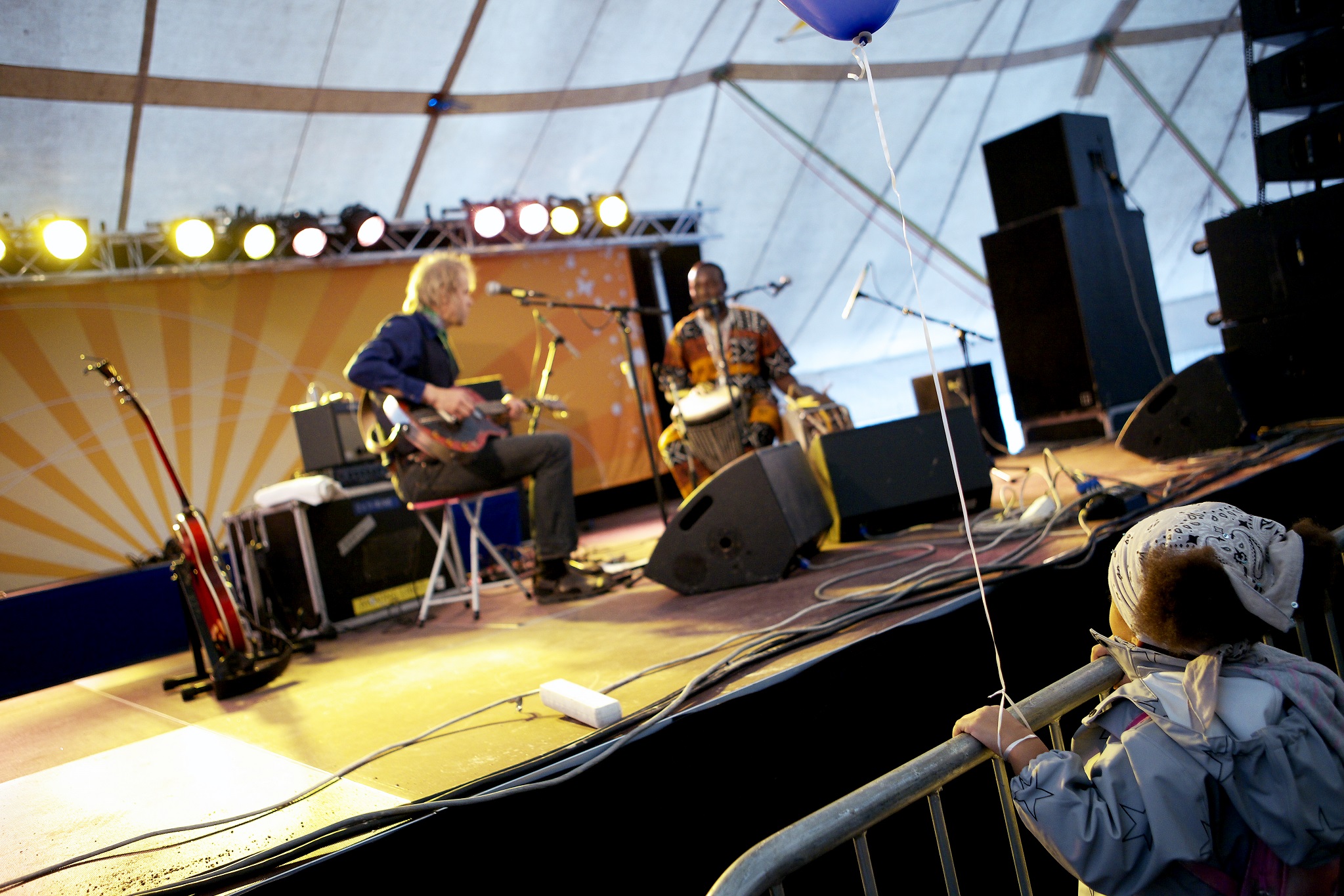
World Village 2009
The main theme of the tenth World Village Festival was climate change. Prime Minister Matti Vanhanen was on hand to participate in a panel on Finnish climate policy, which called for binding agreements on the national, European and global level. Climate was also present in other elements of the factual programme. Kepa’s Globbyists recognised MPs who had done the most to defend development cooperation and fair trade policies, with Pertti Salolainen (National Coalition) emerging as the favourite. The festival was organized in Kaisaniemi and Railway Square 23–24 May 2009.
The main stage featured acts like Colombian La-33, Mozambican Ghorwane, Malian Terakaft and Peruvian Novalima, which also performed a surprise gig at the festival’s closing club night. Finnish highlights included Eino Grön, Jippu, Fat Beat Sound System and children’s favourite Jytäjyrsijät. Monsoon Stage artists included La Casa Bancale from France and Finnish acts Reino & The Rhinos, Maritta Kuula together with the Nartana dance ensemble and harmonica virtuosos Sväng. The evening club held in association with Funky Elephant Festival on Saturday night at Virgin Oil Co. was a huge success, with performers like Canadian The Soul Jazz Orchestra and Up, Bustle & Out from Great Britain.
The festival area was also adorned by climate change themed art, including a Cuban wall installation and a light frame installation by artist Otto Karvonen. The 2009 festival also included a number of side events: The square behind Lasipalatsi hosted a photography exhibition documenting the festival’s history, Galleria Oksasenkatu 11 hosted an exhibition and a discussion on Cuban modern art and Festa Mocambicana hosted by the Tavastia club.
A rainy Saturday hampered visitor numbers, but the additional room on Railway Square helped the festival reach a total audience of roughly 65 000. The festival area was packed with a record number of exhibitioners, nearly 400 in all.
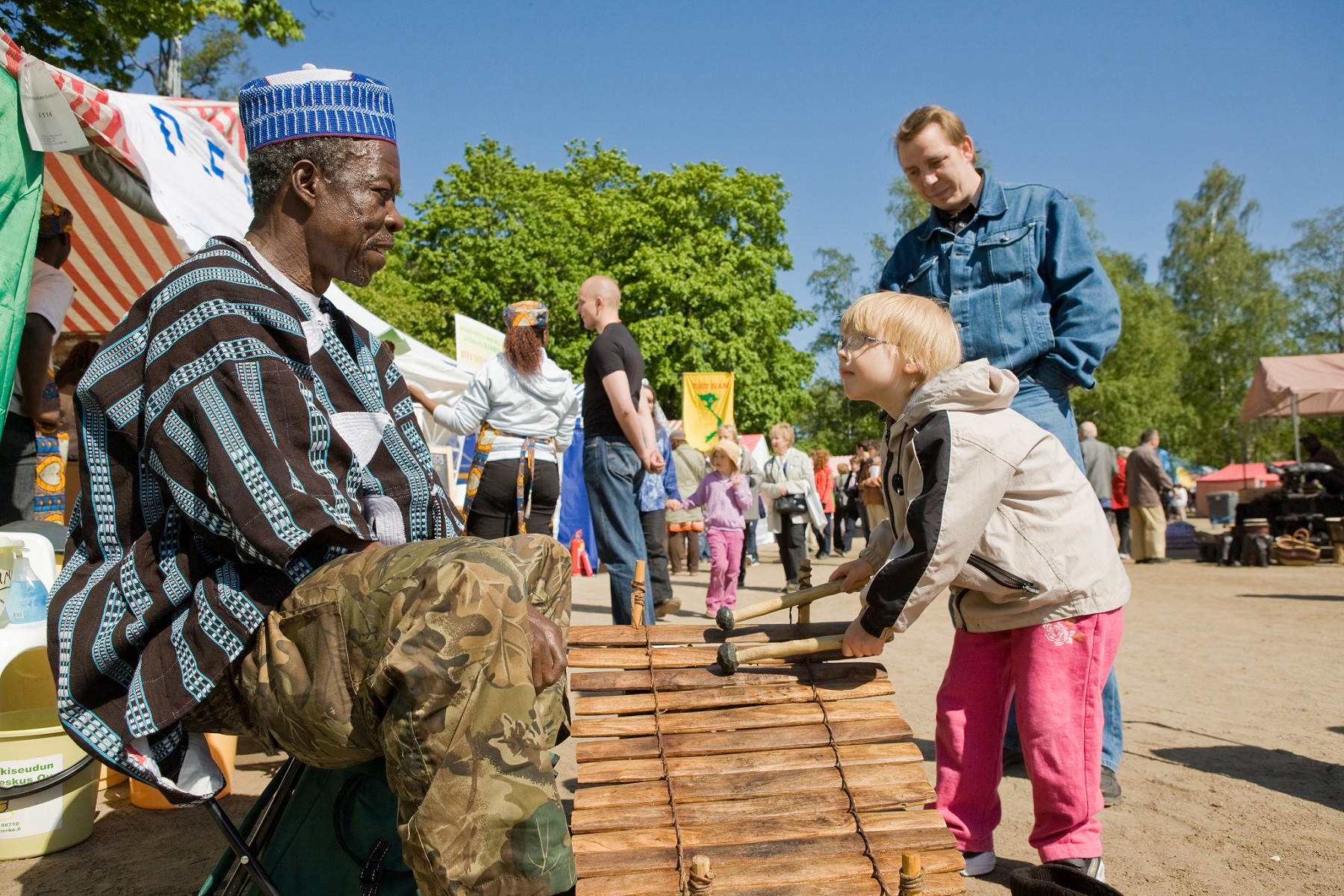
World Village 2008
World Village Festival 2008 broke audience records, thanks to a varied music and factual programme and fine weather over the weekend. The festival was organized in Kaisaniemi, 24–25 May.
Kepa’s theme for the festival was the Globbyists’ Tiedä mitä tankkaat (“Know Your Fuel”) biofuel awareness campaign, which highlighted the effects food crop-based fuels have on food prices and poverty. Kepa was joined at the festival by nearly 300 exhibitioners.
The festival headliner was UNHCR Goodwill Ambassador Barbara Hendricks, who performed courtesy of the UN refugee agency. Hendricks, a resident of Stockholm since 1993, played a fusion of jazz and classical music. Other crowd favourites included Suurlähettiläät, Värttinä, Dissidenten and Malian-French Mamani Keita & Nicolas Repac, who also closed out the festival.
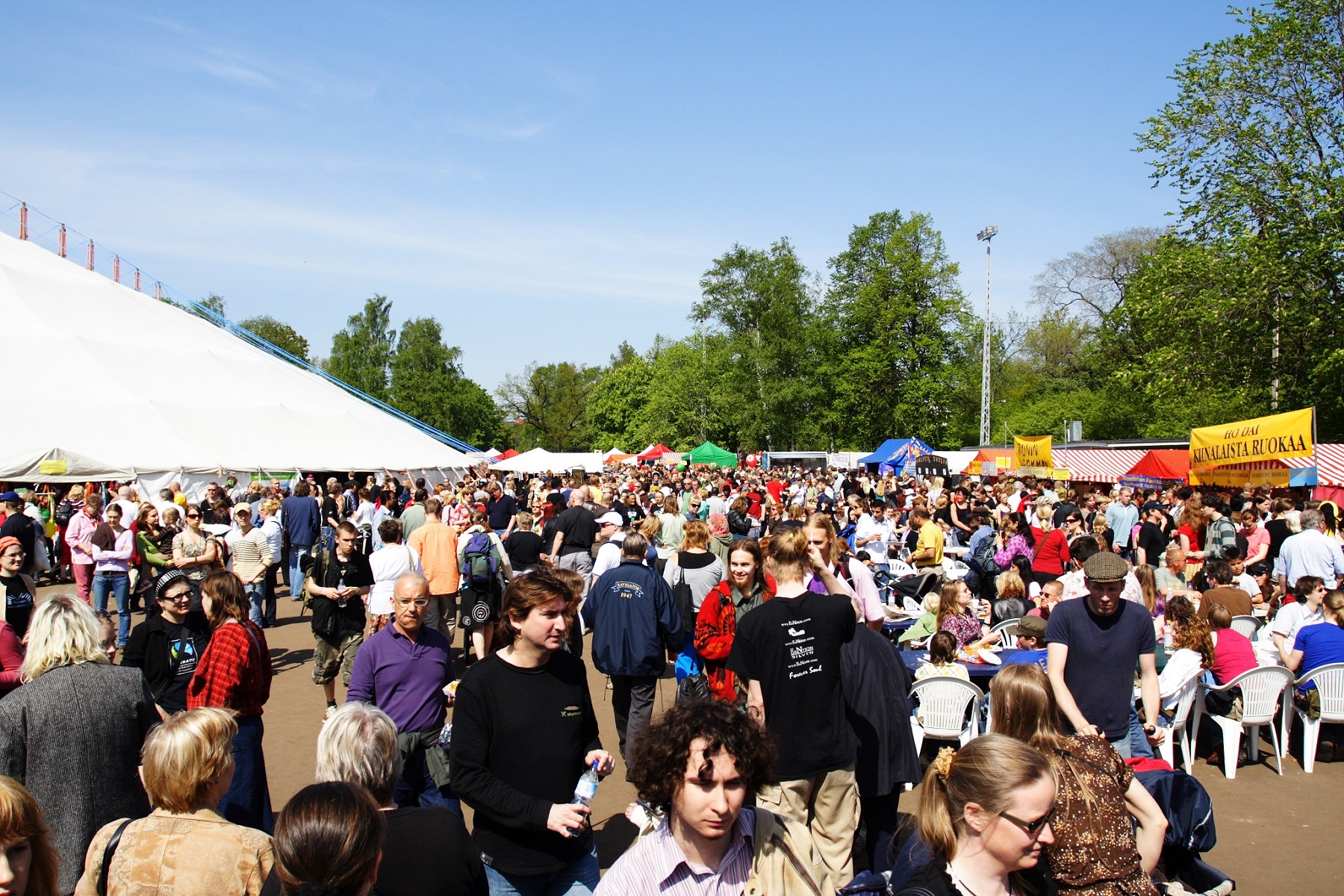
World Village 2007
The 2007 festival featured close to 100 shows and over 300 exhibitors in Kaisaniemi over 26–27 May. The main theme of the festival was climate change, which was discussed, for example, in a panel organised in cooperation with the Ministry for Foreign Affairs.
Two stages were erected in Kaisaniemi to support the music programme, with domestic and international stars alternating between the two. The biggest draws were the multicultural Ska Cubano, the thoroughly Finnish Kari Tapio, La Sarita from Peru and Dirty Babylon Breaker from France. The audience was also treated to the folk music of Swedish-Finnish Gjallarhorn, the ska of The Valkyrians and the Maasai traditions of Kenyan il Murran.
While Saturday was a rainy day at the festival, the crowds came out in large numbers to enjoy the sunny weather on Sunday.
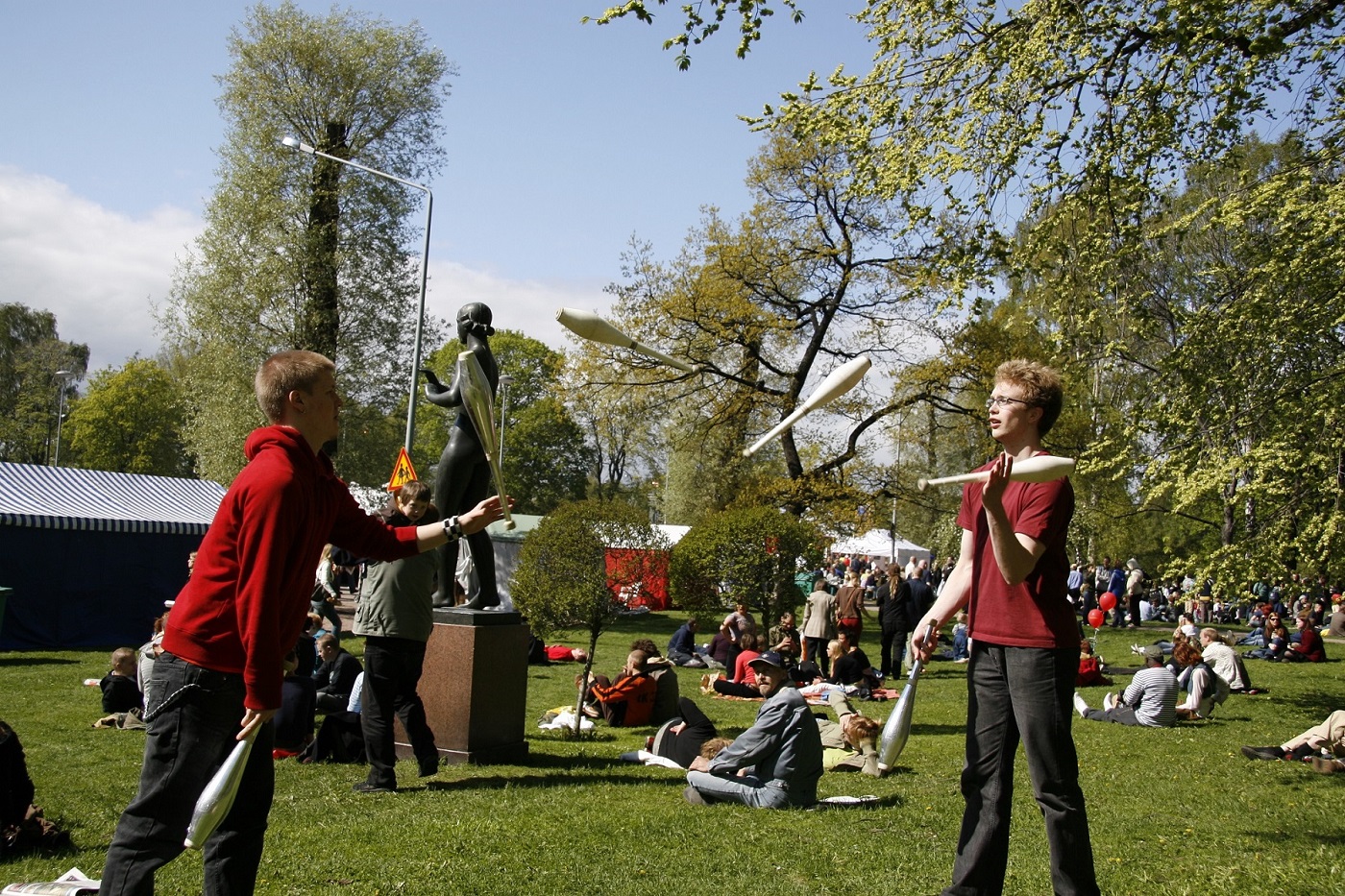
World Village 2006
The seventh World Village Festival was organised in Kaisaniemi Park, Railway Square and Cultural Centre Caisa on 27–28 May . The programme included music, art, activities and views of the world from four continents. The festival was dedicated to volunteerism, without which the festival itself would not be able to delight its visitors in Helsinki.
The festival’s headliners included Nepathya, who performed courtesy of the Finland–Nepal Friendship Association, and Don Johnson Big Band, one of the top names in Finnish hip hop. Nepathya was not the only band from Nepal to appear at the festival, however, as the James Lhomi Group performed in Caisa thanks to an invitation made by the Wycliffe Bible Translators. Festival visitors also got to enjoy shows by La Kinky Beat from Spain, Vietnamese saxophonist Dac Thien Quyen & Trio Töykeät and Indian-English Bhangra rockers Kissmet. The festival’s roster was rounded out by Paukkumaissi, much to the enjoyment of children and the young at heart.
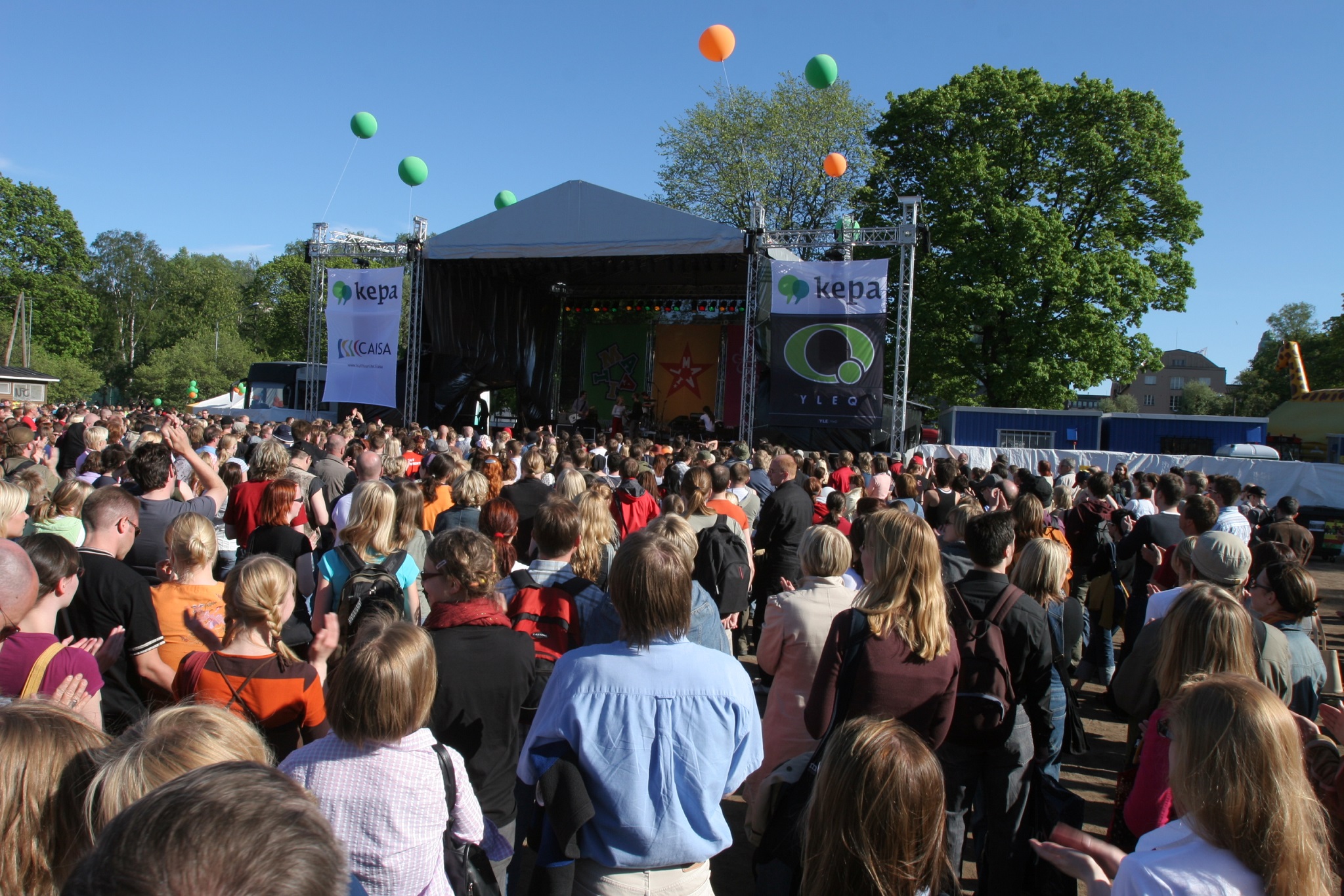
World Village 2005
2005 was the tenth anniversary of World Village Festival, and to celebrate, the festival was turned into an annual event. The festival’s factual programme was also significantly expanded. The festival was held in Kaisaniemi, 28–29 May.
The festival’s main theme was environment, which was especially evident in the Amazonas exhibition, hosted inside a large tent on Railway Square, and in the various environmental CSOs assembled around it. Over a hundred performances were seen over the weekend, including international highlights Cheb Balowski from Spain, Chilean reggae band Gondwana, Somali-English Maryam Mursal and Senegalese hip hop outfit Bogostyle.
Finnish acts included Värttinä, Kimmo Pohjonen Kluster, Jonna Tervomaa and Kymppiorkka, a cover band assembled specifically for World Village Festival. Its members included Paula Vesala, Mariko, Emma Salokoski, Tidjan and Olavi Uusivirta.
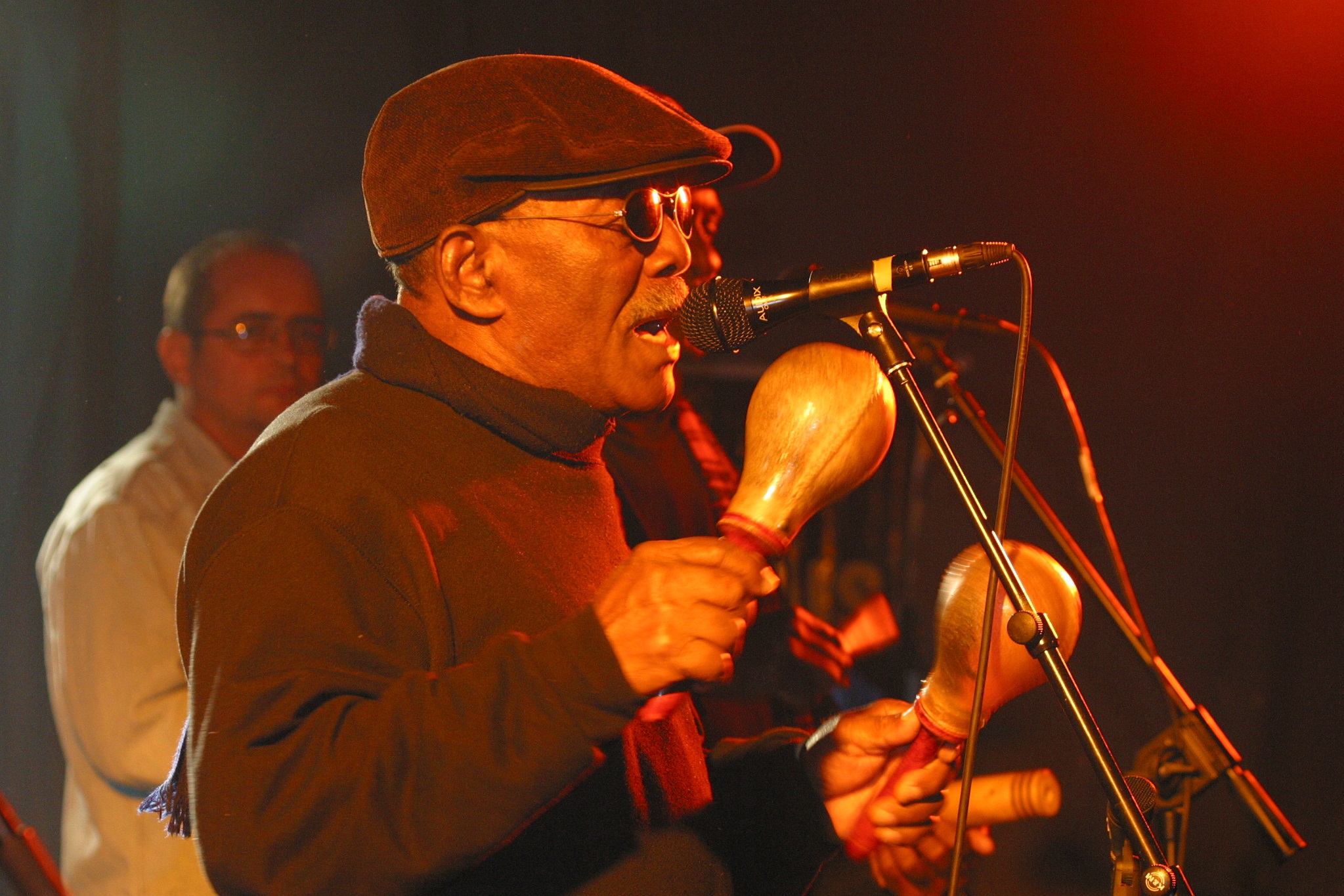
World Village 2003
The festival’s performers included Cuban Los Cumbancheros, South African hip hop group Black Noise and Sembe from Guinea. The festival audience also got to enjoy a performance by Daimokh, the Chechen children’s dance ensemble that managed to journey to the festival despite the appalling conditions in their home country. The festival was organized in Kaisaniemi, 17–18 May.
Finnish performers included Katri Helena, Mariska, Bomfunk MC’s and Maija Vilkkumaa.
The main theme for 2003 was food and thus the festival dedicated a separate tent for food vendors representing cuisines from Finland and around the world. Many in Finland may take food for granted, but Kepa and its member organisations reminded visitors of the hundreds of millions people for whom this basic necessity poses an everyday struggle. In 2001, Kepa and its members launched Ruoka-aika, a campaign aimed at ending world hunger.
The 2003 festival also marked the beginning of national biking week in Finland.
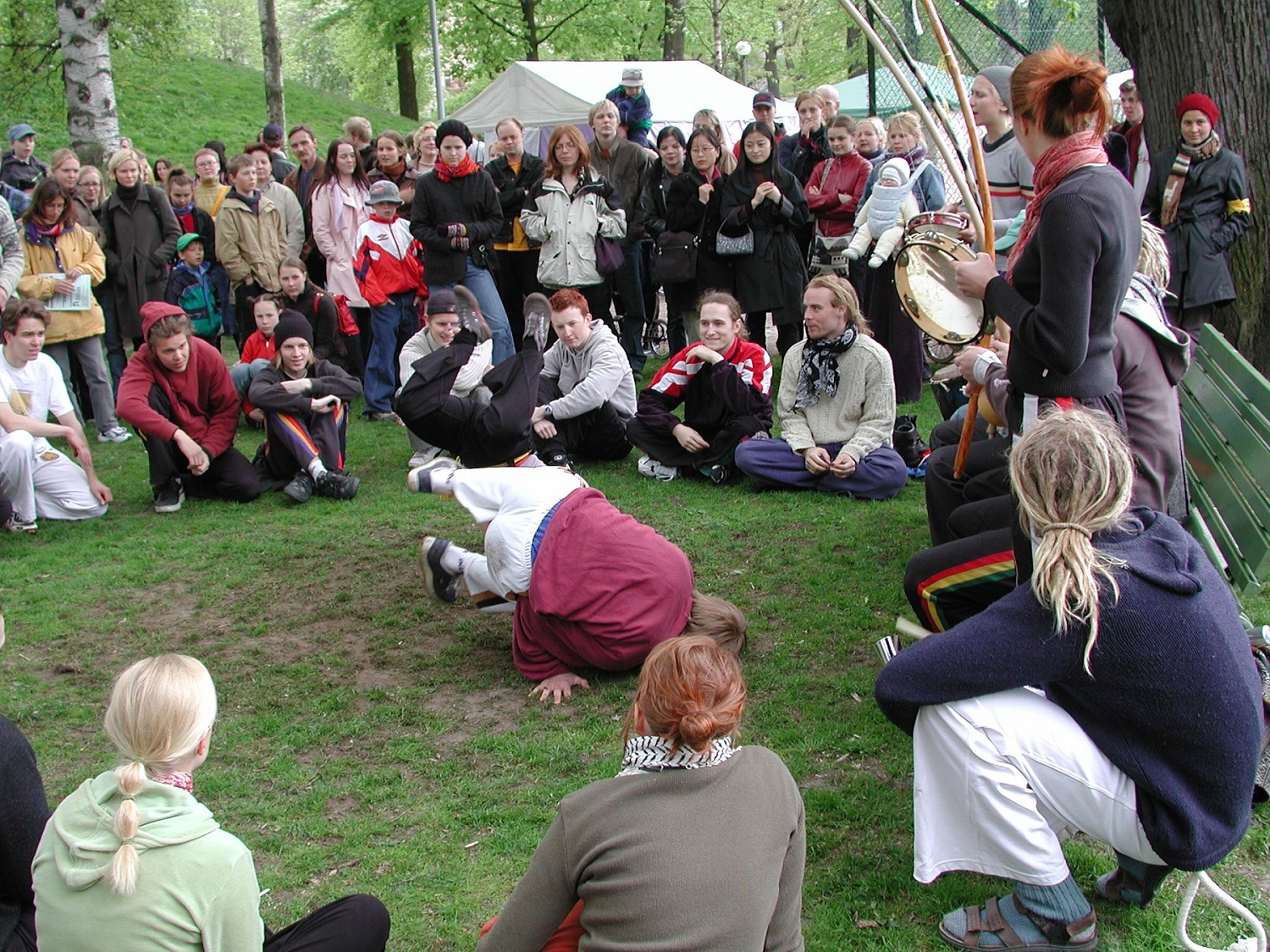
World Village 2001
Fourth World Village was held in Kaisaniemi 26.–27. May 2001. Foreign artists were a throat singing comet Yat-Kha, Senegalese Galaxy, Orquestra Caribe from Cuba and the forerunner of Ska music, Skalites from Jamaica. Cliché, Tasavallan Presidentti, Mari Rantasila, Piirpauke, Ultra Bra, Kwan and Apulanta presented Finland.
Many artists from visual, performance and theater arts were visiting the festival. Special focus was on food and development cooperation. A petition to raise development cooperation funds circulated at the festival and in addition to audience, artists from Galacy, Skalites, Apulanta and Ulta Bra signed it.
The audience was larger than ever before, about 80 000 found their way to the festival of 2001 .
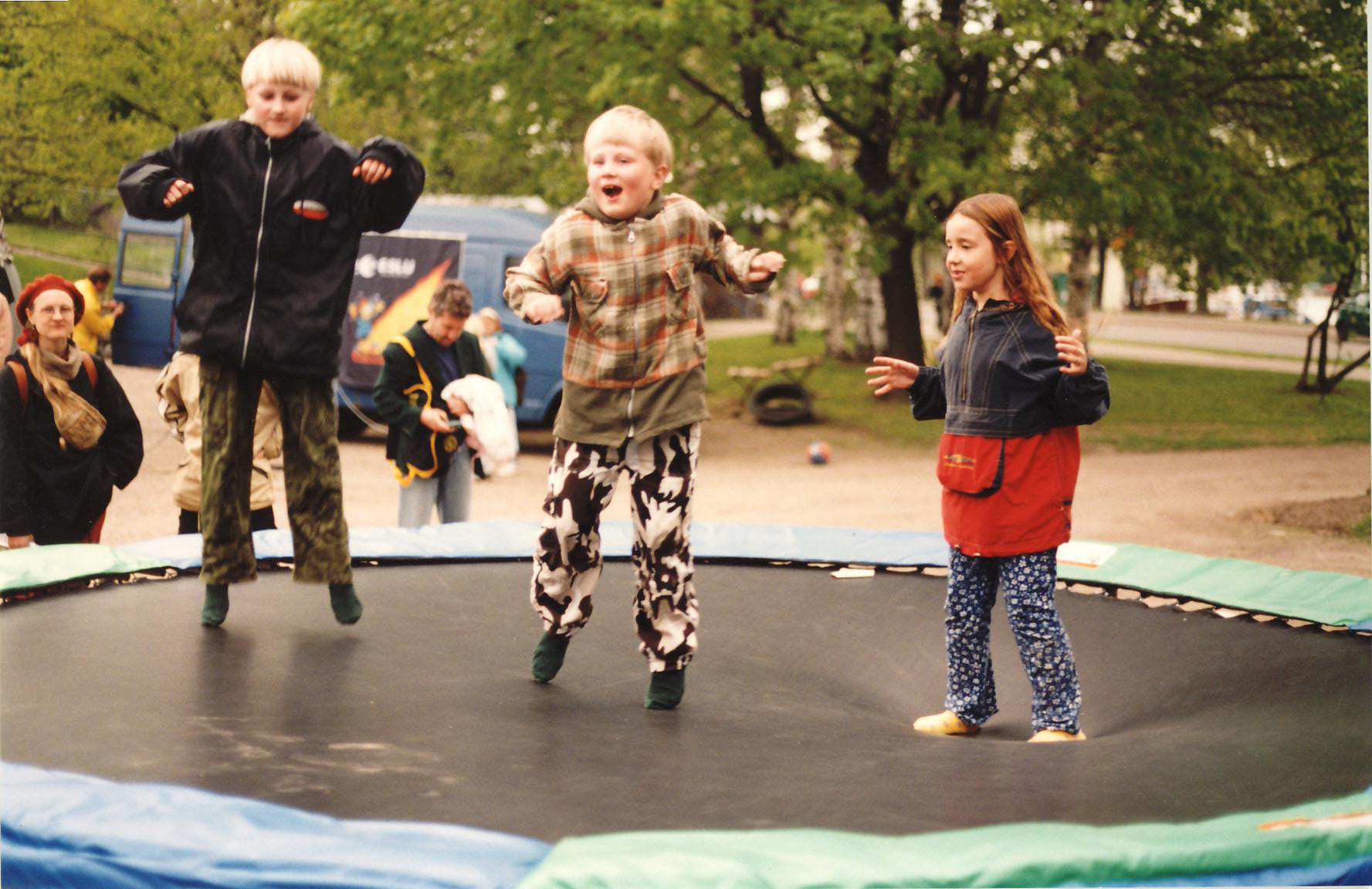
World Village 1999
World Village Festival returned to Kaisaniemi in 29–30 May 1999 with more participants than ever before. The festival’s main theme was the Jubilee 2000 campaign for the cancellation of poor countries’ debts. The festival was also the scene for Felm’s first Jubilee Mass.
The festival lineup included many international guests from Africa. Performers included South African Busi Mhlongo, Cameroonian Sally Nyolo, dance theatre group Casa de Cultura from Mozambique and the Cuban group Klimax.
Finnish performers included Ultra Bra, Eino Grön, Eläkeläiset, Pauli Hanhiniemi & Perunateatteri and Pohjannaula.
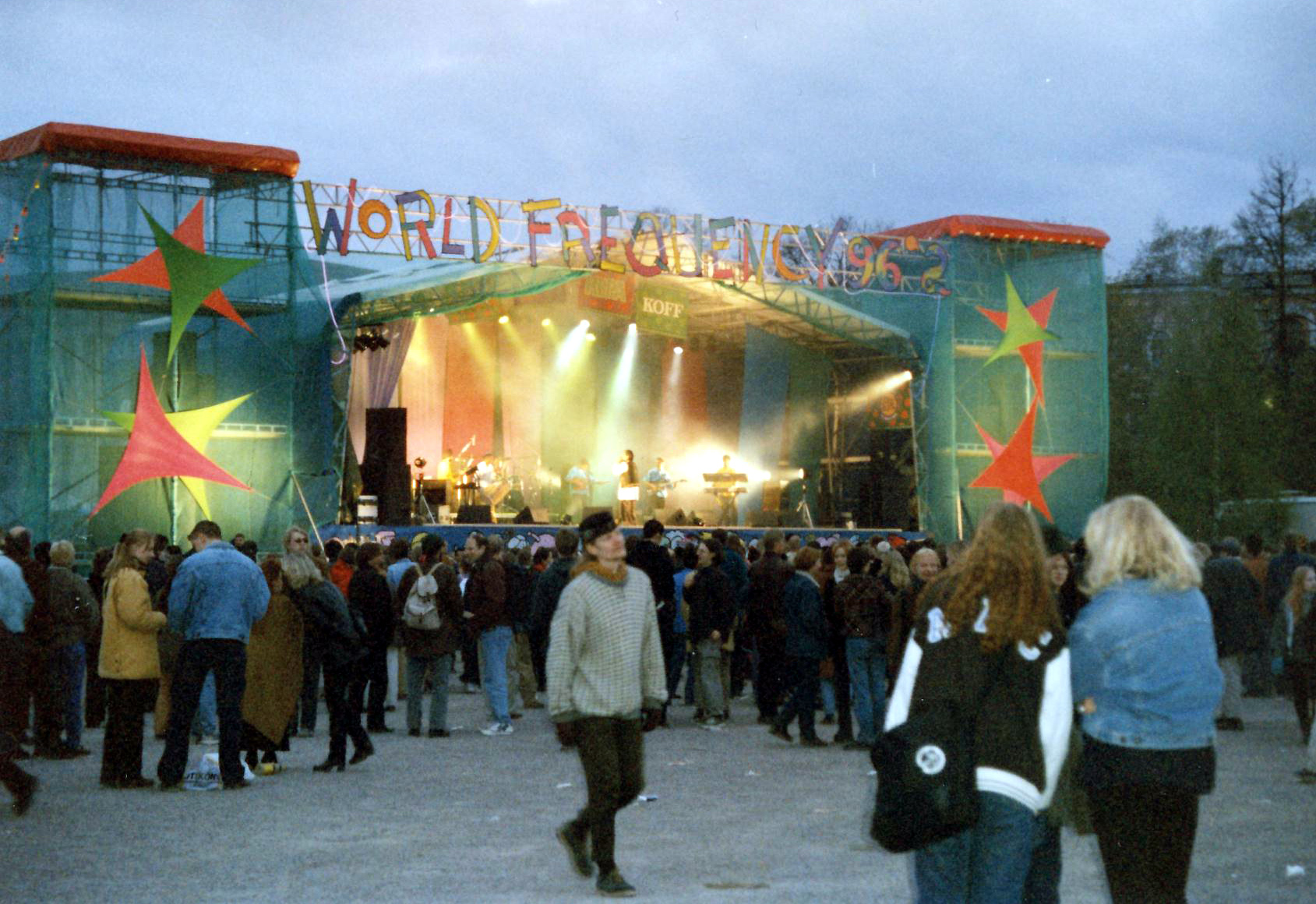
World Village 1997
The second World Village Festival was held at Aurora field and VR warehouses on 24–25 May. The festival moved from Kaisaniemi Park rather unexpectedly, as the recently promoted local pesäpallo (Finnish baseball) team could not come to an agreement with the festival organisers regarding the use of the field in Kaisaniemi Park. While moving the festival to a new location was not a simple task, in the end the festival programme spanned a total of nine stages.
The festival’s themes were ever-timely: human rights, tolerance and multiculturalism. These themes were evident in the performers, the performances as well as other elements of the festival.
The festival paid homage to the Nigerian author-activist Ken-Saro Wiwa, who was killed in October 1995. The poor human rights situation of Nigeria was also a theme in the performance of Nigerian artist Femi Kuti and his band The Positive Force, who continued in the footprints of Kuti’s father, the activist and Afrobeat pioneer Fela Kuti.
International music flavours were also provided by Indian-English Pardesi Bhangra Music Machine and UN Peace Medal-winning reggae band Third World.
Finnish acts were once again numerous. The biggest names included music export royalty in HIM and The 69 Eyes as well as true originals like Tuomari Nurmio and Giant Robot.
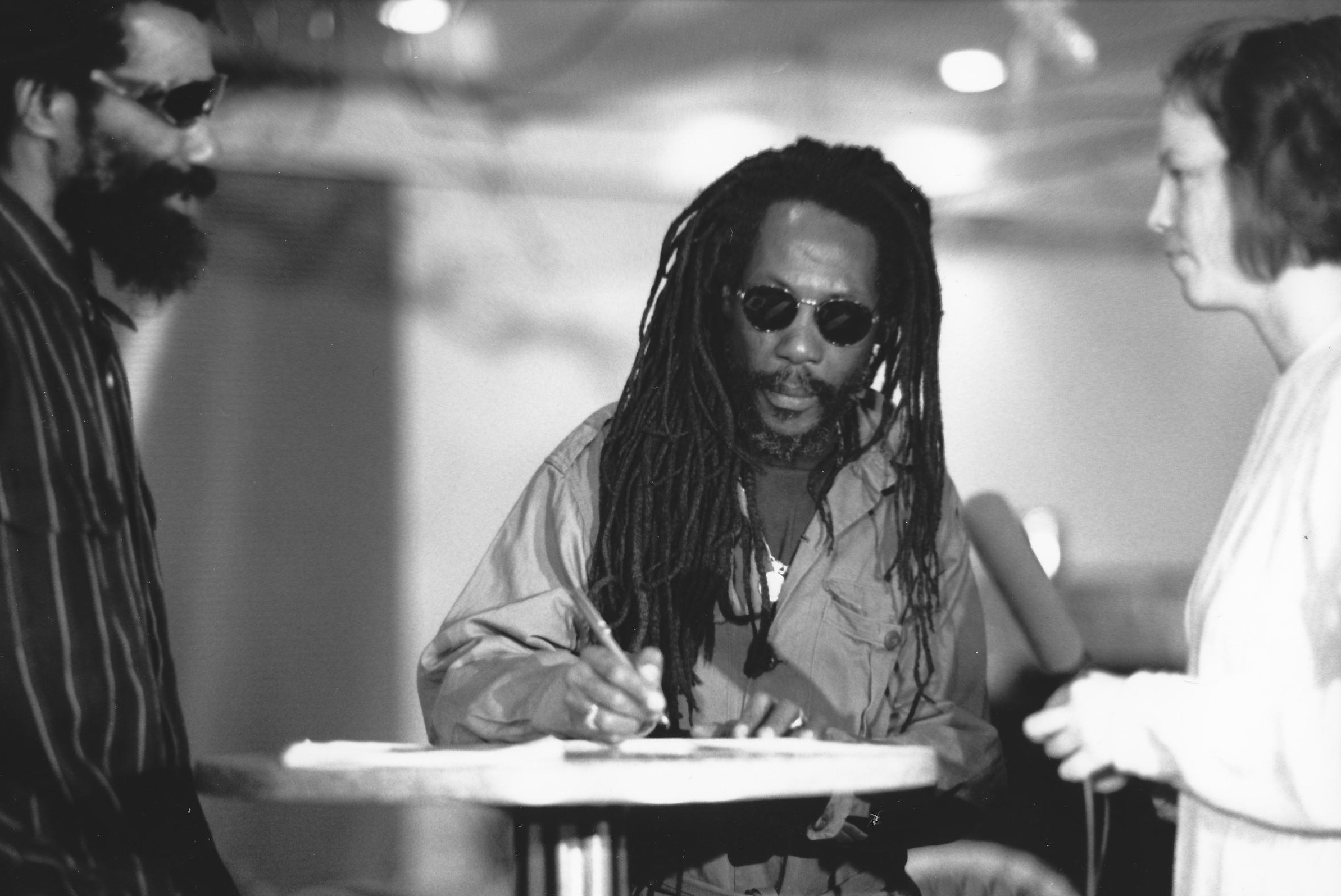
World Village 1995
World Village Festival began its journey in grand fashion, as over 150 CSOs and over one hundred performers assembled in Kaisaniemi, Helsinki. The festival audience measured in the tens of thousands. The end-of-May timing followed in the footsteps of the Market of Possibilities in Helsinki, as the festival was practically built around that event. The first ever World Village festival was organized in Kaisaniemi, 20–21 May 1995.
The first year of the festival was a one-off event and the Finnish main event of the European Council’s campaign against racism. It also marked the tenth anniversary of the Service Centre for Development Cooperation, Kepa.
As new festival looked to distinguish itself from a crowded field of events, the roster of artists had to impress. International guests included Jamaican reggae legend Black Uhuru, US funk-pop-hip hop fusion Defunkt and Kardo from Kurdistan.
Finnish artists included Rasmus, then in the early stages of their career; Kerkko Koskinen Ensemble, later known as Ultra Bra; Angelin tytöt; Ismo Alanko; M.A. Numminen and Pelle Miljoona & Rockers.
